Garmin 02261A Marine Chartplotter with WLAN User Manual
Garmin International Inc Marine Chartplotter with WLAN
Garmin >
Contents
- 1. User manual1
- 2. User manual2
- 3. User manual3
User manual2

GPSMAP
®
Owner’s Manual
August 2013 190-01658-00_0A Printed in Taiwan
DRAFT

All rights reserved. Under the copyright laws, this manual may not be copied, in whole or in part, without the written consent of Garmin. Garmin reserves
the right to change or improve its products and to make changes in the content of this manual without obligation to notify any person or organization of
such changes or improvements. Go to www.garmin.com for current updates and supplemental information concerning the use of this product.
Garmin®, the Garmin logo, BlueChart®, g2 Vision®, and MapSource® are trademarks of Garmin Ltd. or its subsidiaries, registered in the USA and other
countries. echoMAP™, GXM™, and HomePort™ are trademarks of Garmin Ltd. or its subsidiaries. These trademarks may not be used without the
express permission of Garmin.
The Bluetooth® word mark and logos are owned by the Bluetooth SIG, Inc. and any use of such marks by Garmin is under license. iOS® is a registered
trademark of Cisco Systems, Inc. used under license by Apple Inc. microSD™ is a trademark of SD-3C, LLC. NMEA®, NMEA 2000®, and the NMEA
2000 logo are registered trademarks of the National Marine Electronics Association. SiriusXM® is a registered trademark of SiriusXM Radio Inc. All other
trademarks and copyrights are the property of their respective owners. Other trademarks and trade names are those of their respective owners.
DRAFT

Table of Contents
Introduction................................................................ 1
Device Front View................................................................. 1
Device Keys..................................................................... 1
Downloading the Manuals..................................................... 1
GPS Satellite Signals............................................................ 1
Adjusting the Backlight.......................................................... 1
Adjusting the Color Mode...................................................... 1
Customizing the Home Screen.............................................. 1
Inserting Memory Cards........................................................ 1
Charts and 3D Chart Views....................................... 1
Navigation Chart and Offshore Fishing Chart........................ 2
Zooming In and Out of the Chart..................................... 2
Panning the Chart with the Keys..................................... 2
Selecting an Item on the Map Using the Device Keys..... 2
Chart Symbols................................................................. 2
Viewing Location and Object Information on a Chart...... 2
Navigating to a Point on the Chart................................... 3
Viewing Details about Navaids........................................ 3
Premium Charts............................................................... 3
Viewing Tide Station Information............................... 3
Showing Satellite Imagery on the Navigation Chart... 4
Viewing Aerial Photos of Landmarks......................... 4
Automatic Identification System............................................ 4
AIS Targeting Symbols.................................................... 4
Heading and Projected Course of Activated AIS
Targets ............................................................................. 4
Showing AIS Vessels on a Chart or 3D Chart View........ 5
Activating a Target for an AIS Vessel.............................. 5
Viewing Information about a Targeted AIS Vessel.... 5
Deactivating a Target for an AIS Vessel.................... 5
Viewing a List of AIS Threats........................................... 5
Setting the Safe-Zone Collision Alarm............................. 5
AIS Distress Signals........................................................ 5
Navigating to a Distress Signal Transmission............ 5
AIS Distress Signal Device Targeting Symbols......... 5
Enabling AIS Transmission Test Alerts...................... 5
Turning Off AIS Reception............................................... 5
Chart and 3D Chart View Settings......................................... 6
Waypoints and Tracks Settings on the Charts and Chart
Views............................................................................... 6
Other Vessels Settings on the Charts and Chart Views.. 6
AIS Display Settings.................................................. 6
Navigation and Fishing Chart Setup................................ 6
Overlay Numbers Settings............................................... 6
Editing the Data Fields............................................... 6
Showing a Navigation Inset............................................. 7
Chart Appearance Settings.............................................. 7
Fish Eye 3D Settings....................................................... 7
Navigation with a Chartplotter.................................. 7
Basic Navigation Questions................................................... 7
Destinations........................................................................... 8
Searching for a Destination by Name.............................. 8
Selecting a Destination Using the Navigation Chart........ 8
Searching for a Destination Using Nav Info..................... 8
Searching for a Marine Services Destination................... 8
Courses................................................................................. 8
Setting and Following a Direct Course Using Go To....... 8
Setting and Following a Course Using Auto Guidance.... 8
Autopilot Navigation......................................................... 8
Stopping Navigation.............................................................. 9
Waypoints.............................................................................. 9
Marking Your Present Location as a Waypoint................ 9
Creating a Waypoint at a Different Location.................... 9
Marking and Starting Navigation to an MOB Location..... 9
Viewing a List of all Waypoints........................................ 9
Editing a Saved Waypoint................................................ 9
Moving a Saved Waypoint............................................... 9
Browsing for and Navigating to a Saved Waypoint.......... 9
Deleting a Waypoint or an MOB...................................... 9
Deleting All Waypoints..................................................... 9
Routes................................................................................... 9
Creating and Navigating a Route From Your Present
Location........................................................................... 9
Creating and Saving a Route......................................... 10
Viewing a List of Routes................................................ 10
Editing a Saved Route................................................... 10
Browsing for and Navigating a Saved Route................. 10
Browsing for and Navigating Parallel to a Saved Route 10
Deleting a Saved Route................................................. 10
Deleting All Saved Routes............................................. 10
Tracks.................................................................................. 10
Showing Tracks............................................................. 10
Setting the Color of the Active Track............................. 11
Saving the Active Track................................................. 11
Viewing a List of Saved Tracks...................................... 11
Editing a Saved Track.................................................... 11
Saving a Track as a Route............................................ 11
Browsing for and Navigating a Recorded Track............ 11
Deleting a Saved Track................................................. 11
Deleting All Saved Tracks.............................................. 11
Retracing the Active Track............................................. 11
Clearing the Active Track............................................... 11
Managing the Track Log Memory During Recording..... 11
Configuring the Recording Interval of the Track Log..... 11
Deleting All Saved Waypoints, Routes, and Tracks............ 11
Combinations........................................................... 11
Selecting a Combination...................................................... 11
Customizing a Combination Screen.................................... 11
Creating a Custom Combination Screen............................. 12
Deleting a Combination Screen........................................... 12
Gauges and Almanac Information..........................12
Viewing the Compass.......................................................... 12
Viewing Trip Gauges........................................................... 12
Resetting Trip Gauges................................................... 12
Viewing Engine and Fuel Gauges....................................... 12
Customizing Engine Gauge and Fuel Gauge Limits...... 12
Enabling Status Alarms for Engine Gauges.................. 12
Enabling Some Engine Gauge Status Alarms............... 12
Selecting the Number of Engines Shown in Gauges..... 12
Customizing the Engines Shown in Gauges.................. 12
Configuring the Fuel Gauges Display............................ 12
Setting the Fuel Capacity of the Vessel......................... 13
Synchronizing the Fuel Data with the Actual Vessel
Fuel................................................................................ 13
Setting the Fuel Alarm................................................... 13
Viewing the Wind Gauges................................................... 13
Configuring the Speed Source....................................... 13
Configuring the Heading Source of the Wind Gauge..... 13
Selecting the Range of the Close-Hauled Wind Gauge. 13
Viewing the Environment Gauges....................................... 13
Table of Contents i
DRAFT

Configuring the Alignment of the Wind Gauge.............. 13
Configuring the Heading Source of the Environment
Gauge............................................................................ 13
Setting the Barometer Reference Time......................... 13
Tide, Current, and Celestial Information.............................. 13
Tide Station Information................................................. 13
Current Station Information............................................ 13
Celestial Information...................................................... 14
Viewing Tide Station, Current Station, or Celestial
Information for a Different Date..................................... 14
Viewing Information for a Different Tide or Current
Station ............................................................................ 14
Viewing Almanac Information from the Navigation
Chart.............................................................................. 14
Viewing Almanac Information from the Navigation
Chart......................................................................... 14
Radar......................................................................... 14
Radar Display Modes.......................................................... 14
Transmitting Radar Signals................................................. 14
Adjusting the Zoom Scale on the Radar Screen................. 14
Tips for Selecting a Radar Zoom Scale......................... 14
Sentry Mode........................................................................ 15
Enabling Timed Transmit............................................... 15
Setting the Standby and Transmit Times....................... 15
Enabling a Guard Zone.................................................. 15
Defining a Circular Guard Zone..................................... 15
Defining a Partial Guard Zone....................................... 15
Marking a Waypoint on the Radar Screen..................... 15
Viewing a List of AIS Threats......................................... 15
Showing AIS Vessels on the Radar Screen.................. 15
VRM and EBL...................................................................... 16
Showing the VRM and the EBL..................................... 16
Adjusting the VRM and the EBL.................................... 16
Measuring the Range and Bearing to a Target Object.. 16
Radar Overlay..................................................................... 16
Radar Overlay and Chart Data Alignment..................... 16
Showing the Radar Overlay........................................... 16
Stopping the Transmission of Radar Signals...................... 16
Optimizing the Radar Display.............................................. 16
Range of Radar Signals................................................. 16
Radar Gain and Clutter.................................................. 16
Adjusting Gain on the Radar Screen Automatically. 16
Adjusting Gain on the Radar Screen Manually........ 17
Minimizing Nearby Large-Object Interference......... 17
Minimizing Side-Lobe Interference on the Radar
Screen......................................................................17
Adjusting Sea Clutter on the Radar Screen
Automatically............................................................17
Adjusting Rain Clutter on the Radar Screen............ 17
Reducing Cross Talk Clutter on the Radar Screen.. 17
Radar Display Settings.................................................. 17
Radar Appearance Settings........................................... 17
Front-of-Boat Offset....................................................... 18
Measuring the Potential Front-of-Boat Offset.......... 18
Setting the Front-of-Boat Offset............................... 18
Digital Selective Calling.......................................... 18
Networked Chartplotter and VHF Radio Functionality......... 18
Turning On DSC.................................................................. 18
DSC List.............................................................................. 18
Viewing the DSC List..................................................... 18
Adding a DSC Contact................................................... 18
Incoming Distress Calls....................................................... 18
Navigating to a Vessel in Distress................................. 18
Man-Overboard Distress Calls Initiated from a VHF
Radio............................................................................. 18
Man-Overboard Distress Calls Initiated from the
Chartplotter.................................................................... 18
Position Tracking................................................................. 18
Viewing a Position Report.............................................. 19
Navigating to a Tracked Vessel..................................... 19
Creating a Waypoint at the Position of a Tracked
Vessel............................................................................ 19
Editing Information in a Position Report........................ 19
Deleting a Position-Report Call...................................... 19
Viewing Vessel Trails on the Chart................................ 19
Individual Routine Calls....................................................... 19
Selecting a DSC Channel.............................................. 19
Making an Individual Routine Call................................. 19
Making an Individual Routine Call to an AIS Target...... 19
SiriusXM®................................................................. 19
SiriusXM Equipment and Subscription Requirements......... 20
Weather Data Broadcasts................................................... 20
Viewing Precipitation Information........................................ 20
Precipitation Views........................................................ 20
Storm Cell and Lightning Information.................................. 20
Hurricane Information.......................................................... 20
Weather Warnings and Weather Bulletins........................... 20
Forecast Information............................................................ 20
Viewing Forecast Information for Another Time Period. 21
Viewing a Marine Forecast or an Offshore Forecast..... 21
Weather Fronts and Pressure Centers.......................... 21
City Forecasts................................................................ 21
Viewing Sea Conditions....................................................... 21
Surface Winds............................................................... 21
Wave Height, Wave Period, and Wave Direction.......... 21
Viewing Forecast Sea Conditions Information for Another
Time Period................................................................... 21
Viewing Fishing Information................................................ 21
Surface Pressure and Water Temperature Data........... 21
Forecasting Fish Locations............................................ 22
Visibility Information............................................................. 22
Viewing Forecast Visibility Information for Another Time
Period............................................................................ 22
Viewing Buoy Reports......................................................... 22
Viewing Local Weather Information near a Buoy........... 22
Creating a Waypoint on a Weather Chart............................ 22
Weather Overlay.................................................................. 22
Turning On the Weather Overlay on a Chart................. 22
Weather Overlay Settings on the Navigation Chart....... 22
Weather Overlay Settings on the Fishing Chart............ 22
Viewing Weather Subscription Information.......................... 22
SiriusXM Radio.................................................................... 23
Customizing the Channel Guide.................................... 23
Saving a SiriusXM Channel to the Presets List............. 23
Adjusting SiriusXM Satellite Radio Volume................... 23
Device Configuration............................................... 23
Turning On the Chartplotter Automatically.......................... 23
System Settings................................................................... 23
GPS Settings................................................................. 23
Viewing the Event Log................................................... 23
Viewing System Software Information........................... 23
ii Table of Contents
DRAFT

My Vessel Settings.............................................................. 23
Setting the Keel Offset................................................... 23
Setting the Water Temperature Offset........................... 24
Calibrating a Water Speed Device................................. 24
Communications Settings.................................................... 24
NMEA 0183................................................................... 24
NMEA 0183 Settings................................................24
Viewing a List of NMEA 2000 Network Devices............ 25
Setting Up the Wireless Network................................... 25
Connecting a Wireless Device to the Chartplotter... 25
Changing the Wireless Channel.............................. 25
Setting Alarms..................................................................... 25
Navigation Alarms.......................................................... 25
System Alarms............................................................... 25
Setting the Fuel Alarm................................................... 25
Setting Weather Alarms................................................. 25
Units Settings...................................................................... 25
Navigation Settings.............................................................. 25
Auto Guidance Line Configurations............................... 26
Adjusting the Distance from Shore................................ 26
Other Vessel Settings.......................................................... 27
Viewing System Software Information................................. 27
Restoring the Original Chartplotter Factory Settings........... 27
Chartplotter Data Management...............................27
Copying Waypoints, Routes, and Tracks to a Chartplotter.. 27
Copying Data from a Memory Card..................................... 27
Copying Waypoints, Routes, and Tracks to a Memory
Card..................................................................................... 27
Copying Waypoints, Routes, and Tracks to or from all
Chartplotters on the Network............................................... 27
Copying Built-In Maps to a Memory Card............................ 27
Backing Up Data to a Computer.......................................... 27
Restoring Backup Data to a Chartplotter............................. 27
Saving System Information to a Memory Card.................... 28
Appendix.................................................................. 28
Registering Your Device...................................................... 28
Loading the New Software on a Memory Card.................... 28
Updating the Device Software............................................. 28
Screenshots ......................................................................... 28
Capturing Screenshots.................................................. 28
Copying Screenshots to a Computer............................. 28
NMEA 0183 Information...................................................... 28
NMEA 2000 PGN Information............................................. 29
Software License Agreement.............................................. 29
Index......................................................................... 30
Table of Contents iii
DRAFT

DRAFT
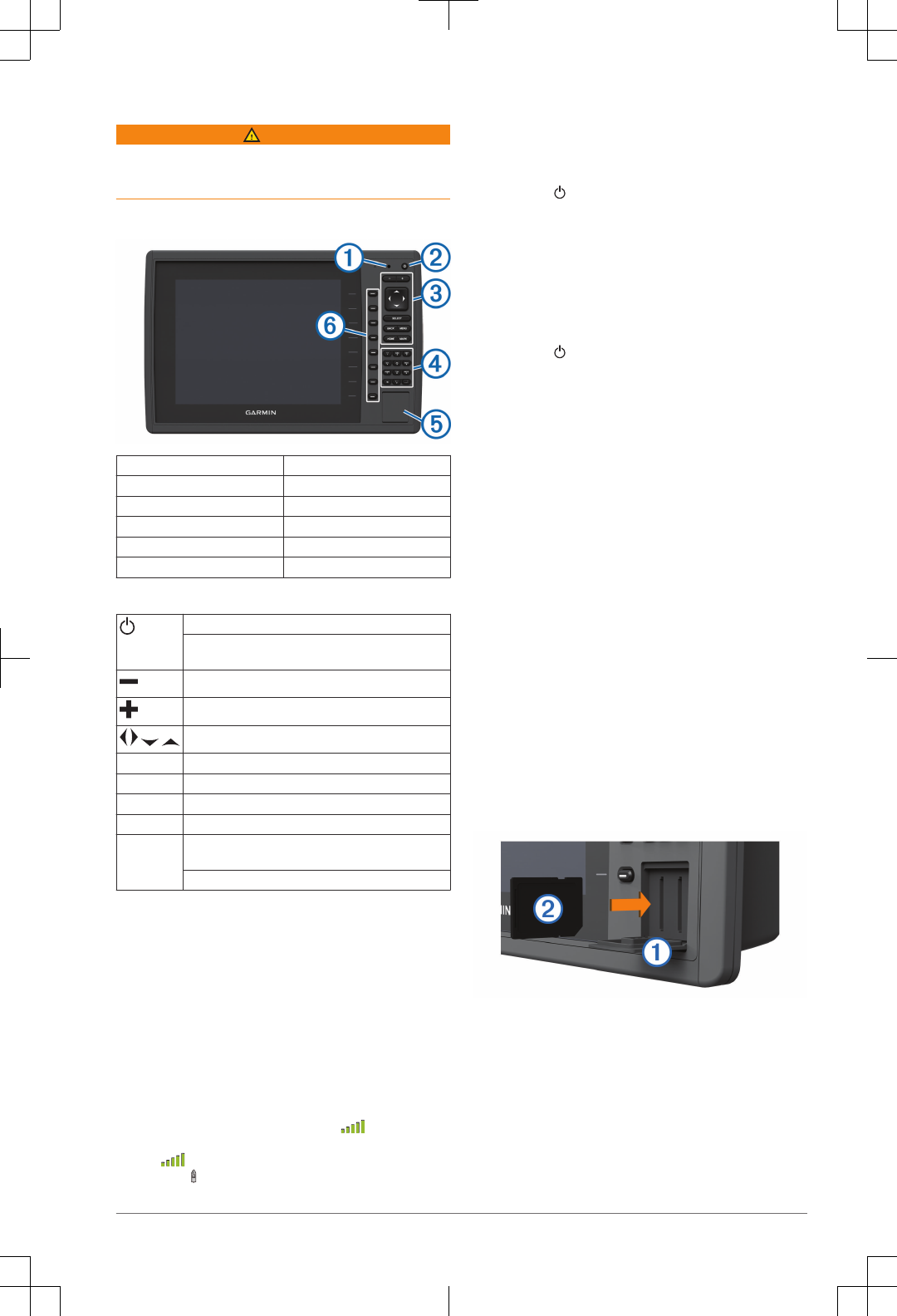
Introduction
WARNING
See the Important Safety and Product Information guide in
the product box for product warnings and other important
information.
Device Front View
ÀAutomatic backlight sensor
ÁPower key
ÂDevice keys
ÃNumber pad
ÄSD memory card slot
ÅSoft keys
Device Keys
Turns on and off the device when held.
Adjusts the backlight and color mode when quickly
pressed and released.
Zooms out of a chart or view.
Zooms in to a chart or view.
Scrolls, highlights options, and moves the cursor.
SELECT Acknowledges messages and selects options.
BACK Returns to the previous screen.
MARK Saves the present location as a waypoint.
HOME Returns to the Home screen.
MENU Opens a menu of options for the page, when
applicable.
Closes a menu, when applicable.
Downloading the Manuals
You can get the latest owner's manual and translations of
manuals from the web.
1Go to www.garmin.com/support.
2Select Manuals.
3Follow the on-screen instructions to download the manual
for your product.
GPS Satellite Signals
When you turn on the chartplotter, the GPS receiver must
collect satellite data and establish the current location. When
the chartplotter acquires satellite signals, appears at the
top of the Home screen. When the chartplotter loses satellite
signals, disappears and a flashing question mark
appears over on the chart.
For more information about GPS, go to www.garmin.com
/aboutGPS.
Adjusting the Backlight
1Select Settings > System > Display > Backlight.
TIP: Press from any screen to access the backlight
settings.
2Select an option:
• Adjust the backlight level.
• Select Auto Backlight or Auto.
Adjusting the Color Mode
1Select Settings > System > Display > Color Mode.
TIP: Press from any screen to access the color
settings.
2Select an option.
Customizing the Home Screen
You can add items to and rearrange items on the Home
screen.
1From the Home screen, select Customize Home.
2Select an option:
• To rearrange an item, select Rearrange, select the
item to move, and select the new location.
• To add an item to the Home screen, select Add, and
select the new item to add.
• To remove an item you have added to the Home
screen, select Remove, and select the item to
remove.
Inserting Memory Cards
You can use optional memory cards in the chartplotter. Map
cards allow you to view high-resolution satellite imagery and
aerial reference photos of ports, harbors, marinas, and other
points of interest. You can use blank memory cards to record
sonar data and transfer data such as waypoints, routes, and
tracks to another compatible Garmin® chartplotter or a
computer.
1Open the access door À on the front of the chartplotter.
2Insert the memory card Á with the label facing to the
right.
3Press the card in until it clicks.
4Close the door.
Charts and 3D Chart Views
The charts and 3D chart views that are available depend on
the map data and accessories used.
Introduction 1
DRAFT
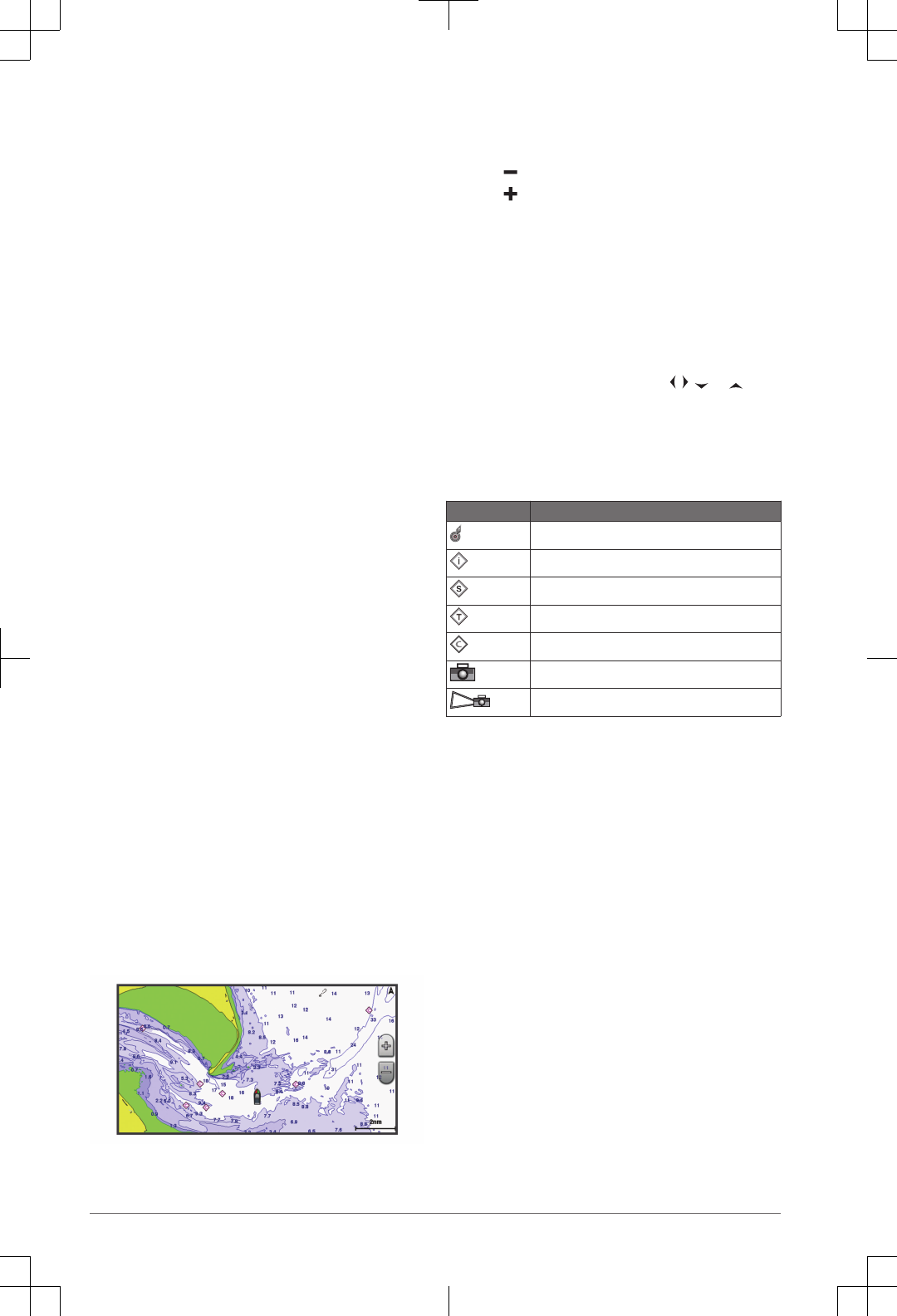
You can access the charts and 3D chart views by selecting
Charts.
Navigation Chart: Shows navigation data available on your
pre-loaded maps and from supplemental maps, if
available. The data includes buoys, lights, cables, depth
soundings, marinas, and tide stations in an overhead
view.
Perspective 3D: Provides a view from above and behind the
boat (according to your course) and provides a visual
navigation aid. This view is helpful when navigating tricky
shoals, reefs, bridges, or channels, and is beneficial when
trying to identify entry and exit routes in unfamiliar
harbors or anchorages.
Mariner’s Eye 3D: Shows a detailed, three-dimensional view
from above and behind the boat (according to your
course) and provides a visual navigation aid. This view is
helpful when navigating tricky shoals, reefs, bridges, or
channels, and when trying to identify entry and exit routes
in unfamiliar harbors or anchorages.
NOTE: Mariner's Eye 3D and Fish Eye 3D chart views
are available with premium charts, in some areas.
Fish Eye 3D: Provides an underwater view that visually
represents the sea floor according to the chart
information. When a sonar transducer is connected,
suspended targets (such as fish) are indicated by red,
green, and yellow spheres. Red indicates the largest
targets and green indicates the smallest.
Fishing Chart: Provides a detailed view of the bottom
contours and depth soundings on the chart. This chart
removes navigational data from the chart, provides
detailed bathymetric data, and enhances bottom contours
for depth recognition. This chart is best for offshore deep-
sea fishing.
NOTE: The offshore Fishing chart is available with
premium charts, in some areas.
Radar Overlay: Superimposes radar information on the
Navigation chart or the Fishing chart, when the
chartplotter is connected to a radar. This feature is not
available with all models.
Navigation Chart and Offshore Fishing
Chart
NOTE: The offshore Fishing chart is available with premium
charts, in some areas.
The Navigation and Fishing charts allows you to plan your
course, view map information, and follow a route. The Fishing
chart is for offshore fishing.
To open the Navigation chart, select Charts > Navigation
Chart.
To open the Fishing chart, select Charts > Fishing Chart.
Zooming In and Out of the Chart
The zoom level is indicated by the scale number at the
bottom of the chart. The bar under the scale number
represents that distance on the chart.
•Select to zoom out.
• Select to zoom in.
Panning the Chart with the Keys
You can move the chart to view an area other than your
present location.
1From the chart, use the arrow keys.
2Select BACK to stop panning and return the screen to
your present location.
Selecting an Item on the Map Using the Device
Keys
1From a chart or 3D chart view, select , , , or to
move the cursor.
2Select SELECT.
Chart Symbols
This table contains some of the common symbols you might
see on the detailed charts.
Icon Description
Buoy
Information
Marine services
Tide station
Current station
Overhead photo available
Perspective photo available
Other features common to most charts include depth contour
lines, intertidal zones, spot soundings (as depicted on the
original paper chart), navigational aids and symbols,
obstructions, and cable areas.
Viewing Location and Object Information on a
Chart
You can view information about a location or an object on the
Navigation chart or the Fishing chart.
NOTE: The offshore Fishing chart is available with premium
charts, in some areas.
1From the Navigation chart or Fishing chart, select a
location or object.
A list of options appears along the right side of the chart.
The options that appear vary based on the location or
object you selected.
2Select an option:
•To view details of objects in the vicinity of the cursor,
select Review.
NOTE: Review does not appear if the cursor is not
near an object. If the cursor is near only one object,
the name of the object appears.
• To navigate to the selected location, select Navigate
To.
• To mark a waypoint at the cursor location, select
Create Waypoint.
2 Charts and 3D Chart Views
DRAFT

• To view the distance and bearing of the object from
your current location, select Measure Distance.
The distance and bearing appear on the screen.
Select Set Reference to measure from a location
other than your current location.
• To view tide, current, celestial, chart notes, or local
services information near the cursor, select
Information.
Navigating to a Point on the Chart
CAUTION
The Auto Guidance feature is based on electronic chart
information. That data does not ensure obstacle and bottom
clearance. Carefully compare the course to all visual
sightings, and avoid any land, shallow water, or other
obstacles that may be in your path.
When using Go To, a direct course and a corrected course
may pass over land or shallow water. Use visual sightings,
and steer to avoid land, shallow water, and other dangerous
objects.
NOTE: The offshore Fishing chart is available with premium
charts, in some areas.
NOTE: Auto Guidance is available with premium charts, in
some areas.
1From the Navigation chart or Fishing chart, select a
location.
2If necessary, select SELECT.
3Select Navigate To.
4Select an option:
• To navigate directly to the location, select Go To.
• To create a route to the location, including turns,
select Route To.
• To use Auto Guidance, select Guide To.
5Review the course indicated by the magenta line.
NOTE: When using Auto Guidance, a gray segment
within any part of the magenta line indicates that Auto
Guidance cannot calculate part of the Auto Guidance line.
This is due to the settings for minimum safe water depth
and minimum safe obstacle height.
6Follow the magenta line, steering to avoid land, shallow
water, and other obstacles.
Viewing Details about Navaids
From the Navigation chart, Fishing chart, Perspective 3D
chart view, or Mariner’s Eye 3D chart view, you can view
details about various types of navigation aids, including
beacons, lights, and obstructions.
NOTE: The offshore Fishing chart is available with premium
charts, in some areas.
NOTE: Mariner's Eye 3D and Fish Eye 3D chart views are
available with premium charts, in some areas.
1From a chart or 3D chart view, select a navaid.
2If necessary, select Review.
3Select the name of the navaid.
Premium Charts
CAUTION
The Auto Guidance feature is based on electronic chart
information. That data does not ensure obstacle and bottom
clearance. Carefully compare the course to all visual
sightings, and avoid any land, shallow water, or other
obstacles that may be in your path.
NOTE: Not all models support all charts.
Optional premium charts, such as BlueChart® g2 Vision®,
allow you to get the most out of your chartplotter. In addition
to detailed marine charting, premium charts may contain
these features, which are available in some areas.
Mariner’s Eye 3D: Provides a view from above and behind
the boat for a three-dimensional navigation aid.
Fish Eye 3D: Provides an underwater, three-dimensional
view that visually represents the sea floor according to
the information on the chart.
Fishing Charts: Shows the chart with enhanced bottom
contours and without navigational data. This chart works
well for offshore deep-sea fishing.
High Resolution Satellite Imagery: Provides high-resolution
satellite images for a realistic view of the land and water
on the Navigation chart (page 4).
Aerial Photos: Shows marinas and other navigationally
significant aerial photos to help you visualize your
surroundings (page 4).
Detailed Roads and POI data: Shows detailed road and
point of interest (POI) data, which includes highly detailed
coastal roads and POIs such as restaurants, lodging, and
local attractions.
Auto Guidance: Uses specified safe depth, safe height, and
chart data to determine the best course to your
destination. Auto Guidance is available when you
navigate to a destination using Guide To.
Viewing Tide Station Information
on the chart indicates a tide station. You can view a
detailed graph for a tide station to help predict the tide level
at different times or on different days.
NOTE: This feature is available with premium charts, in some
areas.
1From the Navigation chart or Fishing chart, select a tide
station.
Tide direction and tide level information appear near .
2Select an option to view additional station information:
• Select the station name.
• If more than one item is in the vicinity, select Review,
and select the station name.
Animated Tide and Current Indicators
NOTE: This feature is available with premium charts, in some
areas.
You can view indicators for animated tide station and current
direction on the Navigation chart or the Fishing chart. You
must also enable animated icons in the chart settings
(page 4).
An indicator for a tide station appears on the chart as a
vertical bar graph with an arrow. A red arrow pointing
downward indicates a falling tide, and a blue arrow pointing
upward indicates a rising tide. When you move the cursor
over the tide station indicator, the height of the tide at the
station appears above the station indicator.
Current direction indicators appear as arrows on the chart.
The direction of each arrow indicates the direction of the
current at a specific location on the chart. The color of the
current arrow indicates the range of speed for the current at
Charts and 3D Chart Views 3
DRAFT
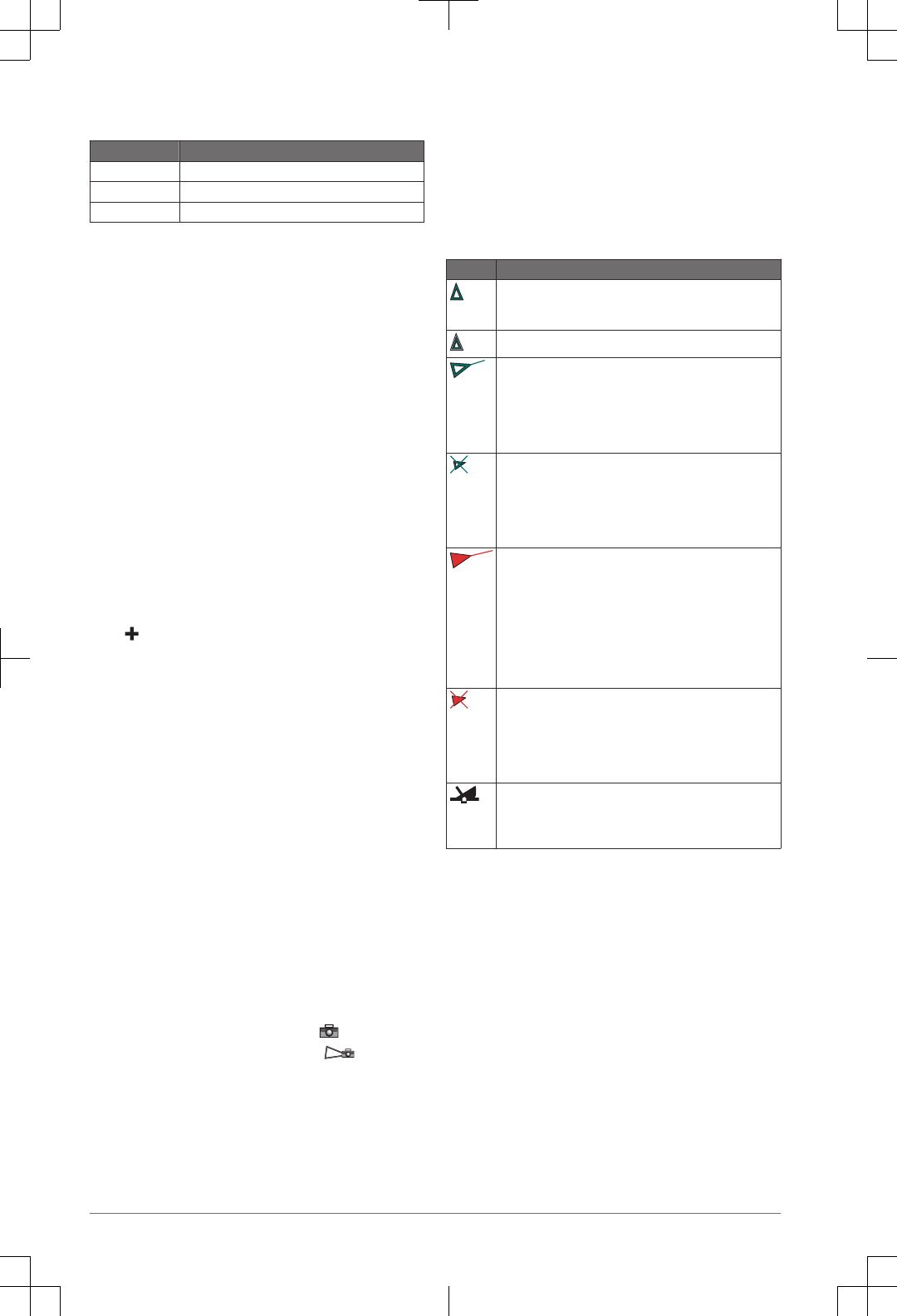
that location. When you move the cursor over the current
direction indicator, the specific current speed at the location
appears above the direction indicator.
Color Current Speed Range
Yellow 0 to 1 knot
Orange 1 to 2 knots
Red 2 or more knots
Showing and Configuring Tides and Currents
NOTE: This feature is available with premium charts, in some
areas.
You can show static or animated tide and current station
indicators on the Navigation chart or Fishing chart.
1From the Navigation or Fishing chart, select MENU >
Chart Setup > Tides & Currents.
2Select an option:
•To show current station indicators and tide station
indicators on the chart, select On.
• To show animated tide station indicators and
animated current direction indicators on the chart,
select Animated.
Showing Satellite Imagery on the Navigation Chart
NOTE: This feature is available with premium charts, in some
areas.
You can overlay high-resolution satellite images on the land
or on both land and sea portions of the Navigation chart.
NOTE: When enabled, high-resolution satellite images are
present only at lower zoom levels. If you cannot see high-
resolution images in your optional chart region, you can
select to zoom in. You also can set the detail level higher
by changing the map zoom detail.
1From the Navigation chart, select MENU > Chart Setup >
Photos.
2Select an option:
•Select Land Only to show standard chart information
on the water, with photos overlaying the land.
• Select Photo Map Blend to show photos on both the
water and the land at a specified opacity. Use the
slider bar to adjust the photo opacity. The higher you
set the percentage, the more the satellite photos
cover both land and water.
Viewing Aerial Photos of Landmarks
Before you can view aerial photos on the Navigation chart,
you must turn on the Photo setting in the chart setup.
NOTE: This feature is available with premium charts, in some
areas.
You can use aerial photographs of landmarks, marinas, and
harbors to help orient yourself to your surroundings or to
acquaint yourself with a marina or a harbor prior to arrival.
1From the Navigation chart, select a camera icon:
• To view an overhead photo, select .
•To view a perspective photo, select . The photo
was taken from the location of the camera, pointed in
the direction of the cone.
2Select Review > Aerial Photo.
Automatic Identification System
The Automatic Identification System (AIS) enables you to
identify and track other vessels, and alerts you to area traffic.
When connected to an external AIS device, the chartplotter
can show some AIS information about other vessels that are
within range, that are equipped with a transponder, and that
are actively transmitting AIS information. The information
reported for each vessel includes the Maritime Mobile
Service Identity (MMSI), location, GPS speed, GPS heading,
time that has elapsed since the last position of the vessel
was reported, nearest approach, and time to the nearest
approach.
AIS Targeting Symbols
Symbol Description
AIS vessel. The vessel is reporting AIS information. The
direction in which the triangle is pointing indicates the
direction in which the AIS vessel is moving.
Target is selected.
Target is activated. The target appears larger on the
chart. A green line attached to the target indicates the
heading of the target. The MMSI, speed, and direction of
the vessel appear beneath the target, if the details setting
has been set to Show. If the AIS transmission from the
vessel is lost, a message banner appears.
Target is lost. A green X indicates that the AIS
transmission from the vessel is lost, and the chartplotter
displays a message banner asking whether the vessel
should continue to be tracked. If you discontinue vessel
tracking, the lost target symbol disappears from the chart
or the 3D chart view.
Dangerous target in range. The target flashes while an
alarm sounds and a message banner appears. After the
alarm has been acknowledged, a solid red triangle with a
red line attached to it indicates the location and the
heading of the target. If the safe-zone collision alarm has
been set to Off, the target flashes, but the audible alarm
does not sound and the alarm banner does not appear. If
the AIS transmission from the vessel is lost, a message
banner appears.
Dangerous target is lost. A red X indicates that the AIS
transmission from the vessel is lost, and the chartplotter
displays a message banner asking whether the vessel
should continue to be tracked. If you discontinue vessel
tracking, the lost dangerous target symbol disappears
from the chart or the 3D chart view.
The location of this symbol indicates the closest point of
approach to a dangerous target, and the numbers near
the symbol indicate the time to the closest point of
approach to that target.
Heading and Projected Course of Activated AIS
Targets
When heading and course over ground information are
provided by an activated AIS target, the heading of the target
appears on a chart as a solid line attached to the AIS target
symbol. A heading line does not appear on a 3D chart view.
The projected course of an activated AIS target appears as a
dashed line on a chart or a 3D chart view. The length of the
projected course line is based on the value of the projected
heading setting. If an activated AIS target is not transmitting
speed information, or if the vessel is not moving, a projected
course line does not appear. Changes in the speed, course
over ground, or rate of turn information transmitted by the
vessel can impact the calculation of the projected course line.
When course over ground, heading, and rate of turn
information are provided by an activated AIS target, the
projected course of the target is calculated based on the
course over ground and the rate of turn information. The
direction in which the target is turning, which is also based on
the rate of turn information, is indicated by the direction of the
4 Charts and 3D Chart Views
DRAFT
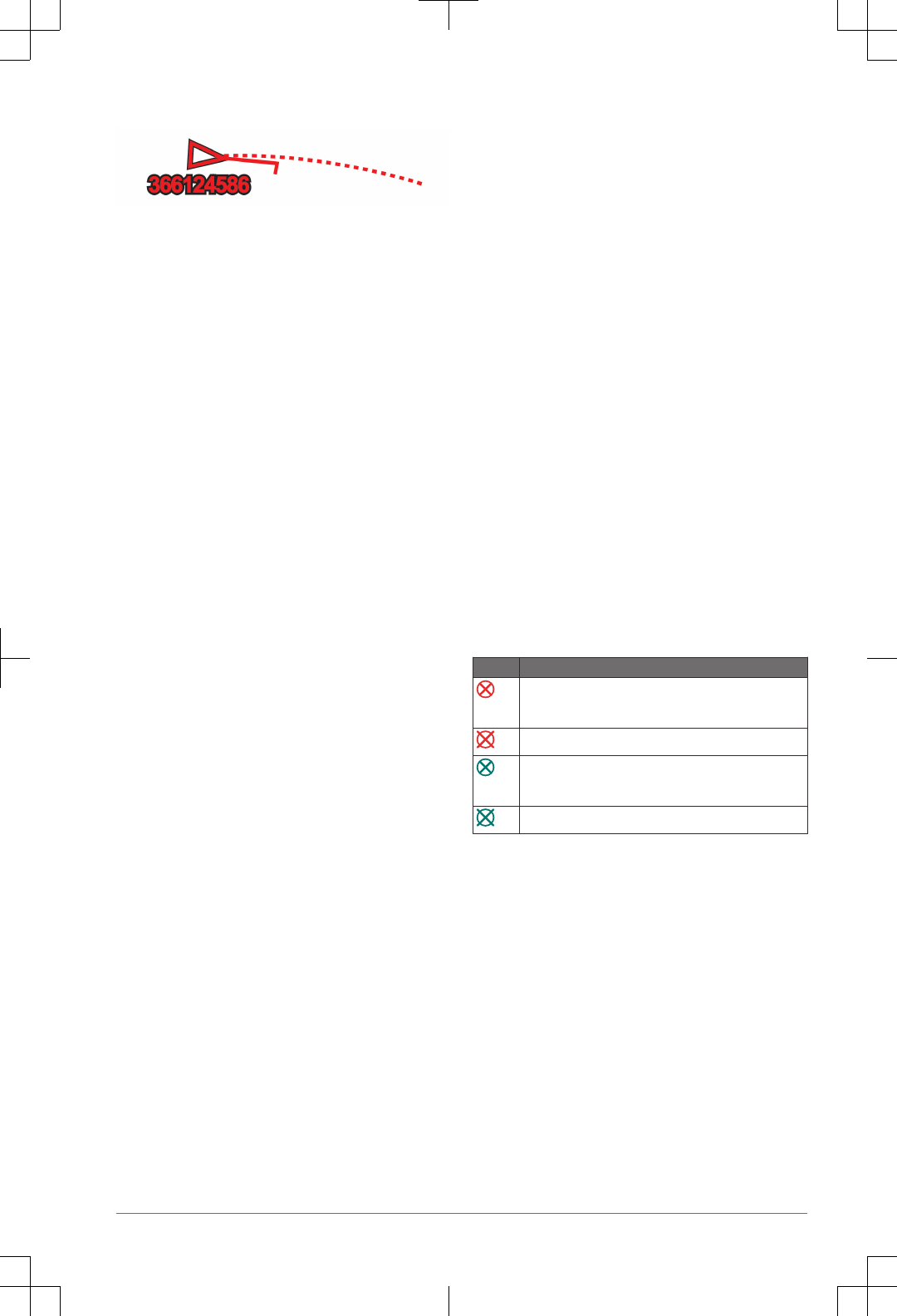
barb at the end of the heading line. The length of the barb
does not change.
When course over ground and heading information are
provided by an activated AIS target, but rate of turn
information is not provided, the projected course of the target
is calculated based on the course over ground information.
Showing AIS Vessels on a Chart or 3D Chart View
Before you can use AIS, you must connect the chartplotter to
an external AIS device and receive active transponder
signals from other vessels.
You can configure how other vessels appear on a chart or on
a 3D chart view. The display range configured for one chart
or one 3D chart view are applied only to that chart or to that
3D chart view. The details, projected heading, and trails
settings configured for one chart or one 3D chart view are
applied to all charts and to all 3D chart views.
1From a chart or 3D chart view, select MENU > Other
Vessels > Display Setup.
2Select an option:
• To indicate the distance from your location in which
AIS vessels appear, select Display Range, and
select a distance.
• To show details about AIS-activated vessels, select
Details > Show.
• To set the projected heading time for AIS-activated
vessels, select Proj. Heading, and enter the time.
• To show the tracks of AIS vessels, select Trails, and
select the length of the track that appears using a
trail.
Activating a Target for an AIS Vessel
1From a chart or a 3D chart view, select an AIS vessel.
2Select AIS Vessel > Activate Target.
Viewing Information about a Targeted AIS Vessel
You can view the AIS signal status, MMSI, GPS speed, GPS
heading, and other information that is reported about a
targeted AIS vessel.
1From a chart or a 3D chart view, select an AIS vessel.
2Select AIS Vessel.
Deactivating a Target for an AIS Vessel
1From a chart or a 3D chart view, select an AIS vessel.
2Select AIS Vessel > Deactivate.
Viewing a List of AIS Threats
From a chart or 3D chart view, select MENU > Other
Vessels > AIS List.
Setting the Safe-Zone Collision Alarm
Before you can set a safe-zone collision alarm, you must
have a compatible chartplotter connected to an AIS device.
The safe-zone collision alarm is used only with AIS. The safe
zone is used for collision avoidance, and can be customized.
1Select Settings > Alarms > AIS > AIS Alarm > On.
A message banner appears and an alarm sounds when
an AIS-activated vessel enters the safe-zone area around
your boat. The object is also labeled as dangerous on the
screen. When the alarm is off, the message banner and
audible alarm are disabled, but the object is still labeled
as dangerous on the screen.
2Select Range.
3Select a distance for the safe-zone radius around your
vessel.
4Select Time To.
5Select a time at which the alarm will sound if a target is
determined to intersect the safe zone.
For example, to be notified of a pending intersection 10
minutes before it will likely occur, set Time To to 10, and
the alarm will sound 10 minutes before the vessel
intersects the safe zone.
AIS Distress Signals
Self-contained AIS distress signal devices transmit
emergency position reports when activated. The chartplotter
can receive signals from Search and Rescue Transmitters
(SART), Emergency Position Indicating Radio Beacons
(EPIRB), and other man overboard signals. Distress signal
transmissions are different than standard AIS transmissions,
so they appear differently on the chartplotter. Instead of
tracking a distress signal transmission for collision avoidance,
you track a distress signal transmission to locate and assist a
vessel or person.
Navigating to a Distress Signal Transmission
When you receive a distress signal transmission, a distress
signal alarm appears.
Select Review > Go To to begin navigation to the
transmission.
AIS Distress Signal Device Targeting Symbols
Symbol Description
AIS distress signal device transmission. Select to see
more information about the transmission and begin
navigation.
Transmission lost.
Transmission test. Appears when a vessel initiates a test
of their distress signal device, and does not represent a
true emergency.
Transmission test lost.
Enabling AIS Transmission Test Alerts
To avoid a large number of test alerts and symbols in
crowded areas such as marinas, you can select to receive or
ignore AIS test messages. To test an AIS emergency device,
you must enable the chartplotter to receive test alerts.
1Select Settings > Alarms > AIS.
2Select an option:
• To receive or ignore Emergency Position Indicating
Radio Beacon (EPRIB) test signals, select AIS-EPIRB
Test.
• To receive or ignore Man Overboard (MOB) test
signals, select AIS-MOB Test.
• To receive or ignore Search and Rescue Transponder
(SART) test signals, select AIS-SART Test.
Turning Off AIS Reception
AIS signal reception is turned on by default.
Select Settings > Other Vessels > AIS > Off.
All AIS functionality on all charts and 3D chart views is
disabled. This includes AIS vessel targeting and tracking,
Charts and 3D Chart Views 5
DRAFT

collision alarms that result from AIS vessel targeting and
tracking, and the display of information about AIS
vessels.
Chart and 3D Chart View Settings
NOTE: Not all settings apply to all charts and 3D chart views.
Some options require premium maps or connected
accessories, such as radar.
These settings apply to the charts and 3D chart views, except
the Radar overlay and Fish Eye 3D (page 7).
From a chart or a 3D chart view, select MENU.
Waypoints & Tracks: See page 6.
Other Vessels: See page 6.
Surface Radar: Shows surface radar details on the
Perspective 3D or Mariner's Eye 3D chart views.
Weather Radar: Shows weather radar imaging on the
Perspective 3D or Mariner's Eye 3D chart views.
Navaids: Shows navigational aids on the Fishing chart.
Laylines: Adjusts the laylines, when in sailing mode ().
Chart Setup: See page 6.
Overlay Numbers: See . This might appear in the Chart
Setup menu.
Chart Appearance: See page 7. This might appear in the
Chart Setup menu.
Waypoints and Tracks Settings on the Charts and
Chart Views
From a chart or a 3D chart view, select MENU > Waypoints
& Tracks.
Tracks: Shows tracks on the chart or 3D chart view.
Waypoints: Shows the Waypoints list (page 9).
New Waypoint: Creates a new waypoint.
Waypoint Display: Sets how to display waypoints on the
chart or 3D chart view.
Active Tracks: Shows the active track options menu.
Saved Tracks: Shows the list of saved tracks (page 11).
Tracks Display: Sets which tracks to display on the chart or
3D chart view based on track color.
Other Vessels Settings on the Charts and Chart
Views
NOTE: These options require connected accessories, such
as an AIS receiver or VHF radio.
From a chart or 3D chart view, select MENU > Other
Vessels.
AIS List: Shows the AIS list (page 5).
DSC List: Shows the DSC list (page 18).
Display Setup: See page 6.
DSC Trails: Shows the tracks of DSC vessels, and selects
the length of the track that appears using a trail.
AIS Alarm: Sets the safe-zone collision alarm (page 5).
AIS Display Settings
NOTE: AIS requires the use of an external AIS device and
active transponder signals from other vessels.
From a chart or 3D chart view, select MENU > Other
Vessels > Display Setup.
AIS Display Range: Indicates the distance from your
location within which AIS vessels appear.
Details: Shows details about AIS-activated vessels.
Proj. Heading: Sets the projected heading time for AIS-
activated vessels.
Trails: Shows the tracks of AIS vessels, and select the length
of the track that appears using a trail.
Navigation and Fishing Chart Setup
NOTE: Not all settings apply to all charts and 3D chart views.
Some settings require external accessories or applicable
premium charts.
From the Navigation chart or Fishing chart, select MENU >
Chart Setup.
Photos: Shows camera icons in some areas when using
some premium charts. This enables you to view aerial
photos of landmarks (page 4).
Tides & Currents: Shows current station indicators and tide
station indicators on the chart (page 4).
Roses: Shows a compass rose around your boat, indicating
compass direction oriented to the heading of the boat. A
true wind direction or apparent wind direction indicator
appears if the chartplotter is connected to a compatible
marine wind sensor. When in sailing mode, true and
apparent wind are shown on the wind rose.
Weather: Sets which weather items are shown on the chart,
when the chartplotter is connected to a compatible
weather receiver with an active subscription.
Lake Level: Allows you to enter the present level of the lake.
Overlay Numbers: See .
Chart Appearance: See page 7.
Overlay Numbers Settings
From a chart, 3D chart view, the Radar screen, or a
Combinations screen, select MENU > Overlay Numbers.
Edit Layout: Sets the layout of the data overlay, or data
fields. You can select the data to be shown within each
data field.
Navigation Inset: Shows the navigation inset when the
vessel is navigating to a destination.
Navigation Inset Setup: Allows you to configure the
navigation inset to show Route Leg Details, and to
control when the inset appears before a turn or
destination.
Compass Tape: Shows the compass tape data bar when the
vessel is navigating to a destination.
Editing the Data Fields
You can change the data shown in the overlay numbers
displayed on the charts, 3D chart views, Combination
screens, Sonar screens, and Radar screens.
1From a screen that supports overlay numbers, select
MENU.
2If necessary, select Chart Setup.
3Select Overlay Numbers > Edit Layout.
4Select a layout.
5Select a data field.
6Select the type of data shown in the field.
Available data options vary based on the chartplotter and
network configuration.
6 Charts and 3D Chart Views
DRAFT
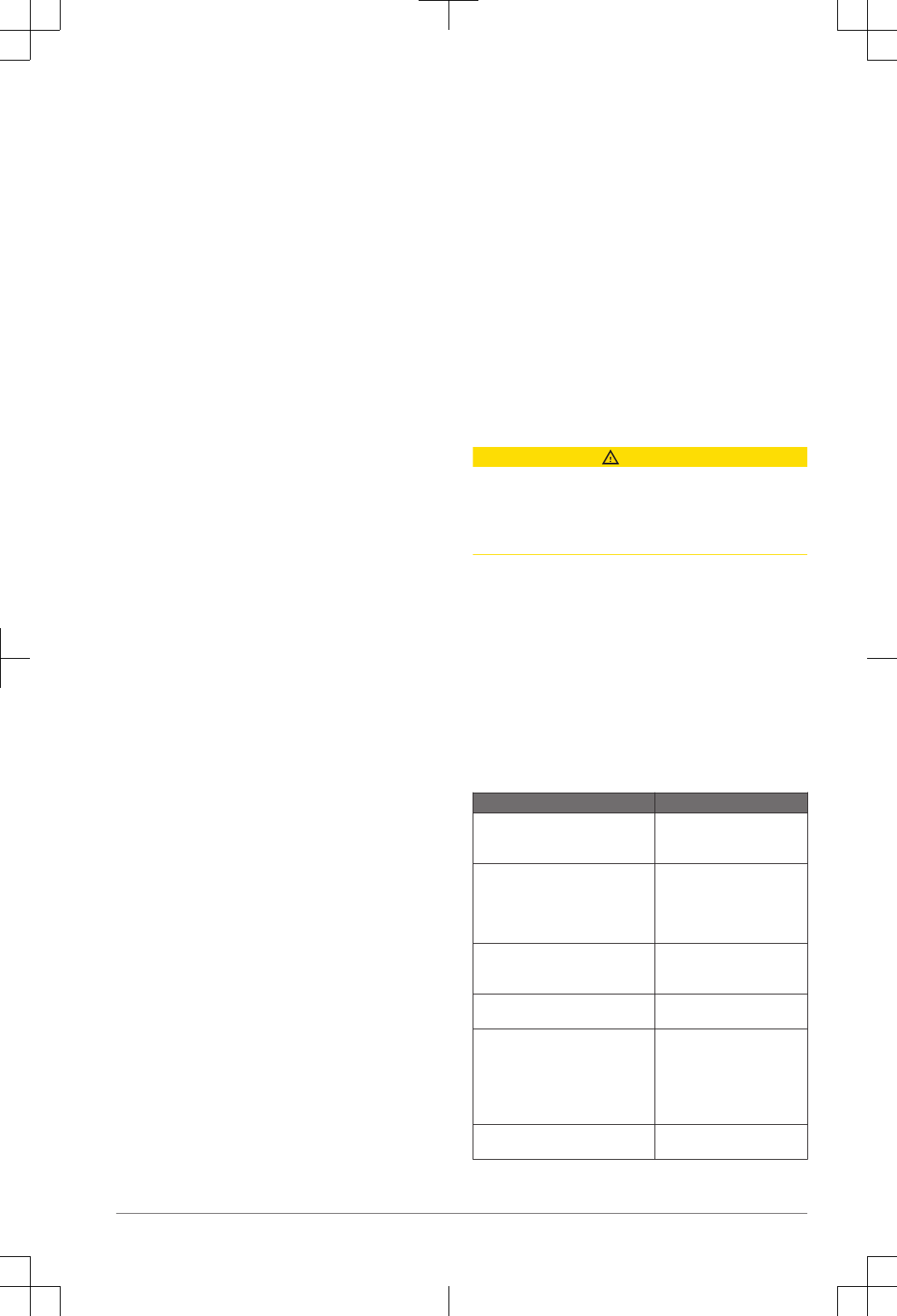
Showing a Navigation Inset
You can control whether a navigation inset appears on some
chart views. The navigation inset is shown only when the
boat is navigating to a destination.
1From a chart or 3D chart view, select MENU.
2If necessary, select Chart Setup.
3Select Overlay Numbers > Navigation Inset > Auto.
4Select Navigation Inset Setup.
5Complete an action:
•To show waypoint velocity made good (VMG) when
navigating a route with more than one leg, select
Route Leg Details > On.
• To show next-turn data based on distance, select
Next Turn > Distance.
• To show next-turn data based on time, select Next
Turn > Time.
• To indicate how the destination data appears, select
Destination, and select an option.
Chart Appearance Settings
You can adjust the appearance of the different chart views.
Each setting is specific for the type of chart view that you are
in.
NOTE: Not all settings apply to all charts and 3D chart views
and chartplotter models. Some options require premium
maps or connected accessories, such as radar.
From a chart or 3D chart view, select MENU > Chart Setup >
Chart Appearance.
Orientation: Sets the perspective of the map.
Detail: Adjusts the amount of detail shown on the map, at
different zoom levels.
Heading Line: Shows and adjusts the heading line, which is
a line drawn on the map from the bow of the boat in the
direction of travel, and sets the data source for the
heading line.
World Map: Uses either a basic world map or a shaded relief
map on the chart. These differences are visible only when
zoomed out too far to see the detailed charts.
Spot Depths: Turns on spot soundings and sets a
dangerous depth. Spot depths that are equal to or more
shallow than the dangerous depth are indicated by red
text.
Safety Shading: Sets the shades from the shoreline to the
specified depth.
Depth Range Shading: Specifies an upper and lower depth
to shade between.
Symbols: Shows and configures the appearance of various
symbols on the chart, such as the vessel icon, navaid
symbols, land POIs, and light sectors.
Style: Sets how the chart appears over 3D terrain.
Hazard Colors: Shows shallow water and land with a color
scale. Blue indicates deep water, yellow is shallow water,
and red is very shallow water.
Safe Depth: Sets the appearance of a safe depth for
Mariner’s Eye 3D.
NOTE: This setting affects only the appearance of hazard
colors in Mariner’s Eye 3D. It does not affect the safe
water depth Auto Guidance setting or the sonar shallow
water alarm setting.
Range Rings: Shows and configures the appearance of
range rings, which help you to visualize distances in
some chart views.
Lane Width: Specifies the width of the navigation lane, which
is the magenta line in some chart views that indicates the
course to your destination.
Fish Eye 3D Settings
NOTE: This feature is available with premium charts, in some
areas.
From the Fish Eye 3D chart view, select MENU.
View: Sets the perspective of the 3D chart view.
Tracks: Shows tracks.
Sonar Cone: Shows a cone that indicates the area covered
by the transducer.
Fish Symbols: Shows suspended targets.
Navigation with a Chartplotter
CAUTION
The Auto Guidance feature is based on electronic chart
information. That data does not ensure obstacle and bottom
clearance. Carefully compare the course to all visual
sightings, and avoid any land, shallow water, or other
obstacles that may be in your path.
To navigate, you must choose a destination, set a course or
create a route, and follow the course or route. You can follow
the course or the route on the Navigation chart, Fishing chart,
Perspective 3D chart view, or Mariner’s Eye 3D chart view.
NOTE: Auto Guidance is available with premium charts, in
some areas.
NOTE: Mariner's Eye 3D and Fish Eye 3D chart views are
available with premium charts, in some areas.
NOTE: The offshore Fishing chart is available with premium
charts, in some areas.
Basic Navigation Questions
Question Answer
How do I make the chartplotter
point me in the direction in which I
want to go (bearing)?
Navigate using Go To. See
page 8.
How do I make the device guide me
along a straight line (minimizing
cross track) to a location using the
shortest distance from the present
location?
Build a single-leg route and
navigate it using Route To.
See page 9.
How do I make the device guide me
to a location while avoiding charted
obstacles?
Build a multi-leg route and
navigate it using Route To.
See page 9.
How do I make the device steer my
automatic pilot?
Navigate using Route To. See
page 9.
Can the device create a path for
me?
If you have premium maps
that support Auto Guidance
and are in an area covered by
Auto Guidance, navigate
using Auto Guidance. See
page 8.
How do I change the Auto
Guidance settings for my boat?
See page 26.
Navigation with a Chartplotter 7
DRAFT

Destinations
You can select destinations using various charts and 3D
chart views or using the lists.
Searching for a Destination by Name
You can search for saved waypoints, saved routes, saved
tracks, and marine services destinations by name.
1Select Nav Info > Search by Name.
2Enter at least a portion of the name of your destination.
3If necessary, select Done.
The 50 nearest destinations that contain your search
criteria appear.
4Select the destination.
Selecting a Destination Using the Navigation Chart
From the Navigation chart, select a destination.
Searching for a Destination Using Nav Info
1Select Nav Info.
2Select an option:
•To view a list of preloaded locations and previously
marked locations, select Waypoints.
• To view a list of previously saved routes, select
Routes.
• To view a list of recorded tracks, select Tracks.
• To view a list of slips, moorings, and other offshore
points of interest, select Offshore Services.
• To view a list of marinas and other inland points of
interest, select Inland Services.
• To search for a destination by name, select Search
by Name.
3Select a destination.
Searching for a Marine Services Destination
NOTE: This feature is available with premium charts, in some
areas.
The chartplotter contains information for thousands of
destinations offering marine services.
1Select Nav Info.
2Select Offshore Services or Inland Services.
3If necessary, select the marine service category.
The chartplotter shows a list of the nearest locations and
the distance and bearing to each.
4Select a destination.
You can select or to view additional information or to
show the location on a chart.
Courses
CAUTION
The Auto Guidance feature is based on electronic chart
information. That data does not ensure obstacle and bottom
clearance. Carefully compare the course to all visual
sightings, and avoid any land, shallow water, or other
obstacles that may be in your path.
When using Go To, a direct course and a corrected course
may pass over land or shallow water. Use visual sightings,
and steer to avoid land, shallow water, and other dangerous
objects.
NOTE: Auto Guidance is available with premium charts, in
some areas.
You can set and follow a course to a destination using one of
three methods: Go To, Route To, or Guide To.
Go To: Takes you directly to the destination.
Route To: Creates a route from your location to a
destination, allowing you to add turns along the way.
Guide To: Create a path to a destination using Auto
Guidance.
Setting and Following a Direct Course Using Go To
CAUTION
When using Go To, a direct course and a corrected course
may pass over land or shallow water. Use visual sightings,
and steer to avoid land, shallow water, and other dangerous
objects.
You can set and follow a direct course from your current
location to a selected destination.
1Select a destination (page 8).
2Select Navigate To > Go To.
A magenta line appears. In the center of the magenta line
is a thinner purple line that represents the corrected
course from your current location to the destination. The
corrected course is dynamic, and it moves with your boat
when you are off course.
3Follow the magenta line, steering to avoid land, shallow
water, and other obstacles.
4If you are off course, follow the purple line (corrected
course) to go to your destination, or steer back to the
magenta line (direct course).
Setting and Following a Course Using Auto
Guidance
CAUTION
The Auto Guidance feature is based on electronic chart
information. That data does not ensure obstacle and bottom
clearance. Carefully compare the course to all visual
sightings, and avoid any land, shallow water, or other
obstacles that may be in your path.
NOTE: Auto Guidance is available with premium charts, in
some areas.
1Select a destination (page 8).
2Select Navigate To > Guide To.
3Review the course indicated by the magenta Auto
Guidance line.
4Follow the magenta line, steering to avoid land, shallow
water, and other obstacles.
NOTE: When using Auto Guidance, a gray segment
within any part of the magenta line indicates that Auto
Guidance cannot calculate part of the Auto Guidance line.
This is due to the settings for minimum safe water depth
and minimum safe obstacle height.
Autopilot Navigation
When you start navigation (Go To, Route To, or Guide To), if
you are connected through a NMEA 2000® network to a
compatible Garmin autopilot, you are prompted to engage the
autopilot.
8 Navigation with a Chartplotter
DRAFT

Stopping Navigation
From the Navigation chart or Fishing chart, select MENU
> Stop Navigation.
Waypoints
Waypoints are locations you record and store in the device.
Marking Your Present Location as a Waypoint
From any screen, select MARK.
Creating a Waypoint at a Different Location
1Select Nav Info > Waypoints > Create Waypoint.
2Select an option:
•To create the waypoint by entering position
coordinates, select Enter Coordinates, and enter the
coordinates.
• To create the waypoint using a chart, select Use
Chart, select the location, and select Move
Waypoint.
Marking and Starting Navigation to an MOB
Location
When you mark a waypoint, you can designate it as a man
overboard (MOB) location.
Select an option:
• From any screen, select MARK > Man Overboard.
• From the Home screen, select Man Overboard >
Yes.
An international MOB symbol marks the active MOB point
and the chartplotter sets a direct course back to the marked
location.
Viewing a List of all Waypoints
Select Nav Info > Waypoints.
Editing a Saved Waypoint
1Select Nav Info > Waypoints.
2Select a waypoint.
3Select Edit Waypoint.
4Select an option:
• To add a name, select Name, and enter a name.
• To change the symbol, select Symbol.
• To change the depth, select Depth.
• To change the water temperature, select Water
Temp..
• To change the comment, select Comment.
• To move the position of the waypoint, select Move.
Moving a Saved Waypoint
1Select Nav Info > Waypoints.
2Select a waypoint.
3Select Edit Waypoint > Move.
4Indicate a new location for the waypoint:
• To move the waypoint while using the chart, select
Use Chart, select a new location on the chart, and
select Move Waypoint.
• To move the waypoint using coordinates, select Enter
Coordinates, and enter the new coordinates.
Browsing for and Navigating to a Saved Waypoint
CAUTION
The Auto Guidance feature is based on electronic chart
information. That data does not ensure obstacle and bottom
clearance. Carefully compare the course to all visual
sightings, and avoid any land, shallow water, or other
obstacles that may be in your path.
When using Go To, a direct course and a corrected course
may pass over land or shallow water. Use visual sightings,
and steer to avoid land, shallow water, and other dangerous
objects.
NOTE: Auto Guidance is available with premium charts, in
some areas.
Before you can navigate to a waypoint, you must create a
waypoint.
1Select Nav Info > Waypoints.
2Select a waypoint.
3Select Navigate To.
4Select an option:
• To navigate directly to the location, select Go To.
• To create a route to the location, including turns,
select Route To.
• To use Auto Guidance, select Guide To.
5Review the course indicated by the magenta line.
NOTE: When using Auto Guidance, a gray segment
within any part of the magenta line indicates that Auto
Guidance cannot calculate part of the Auto Guidance line.
This is due to the settings for minimum safe water depth
and minimum safe obstacle height.
6Follow the magenta line, steering to avoid land, shallow
water, and other obstacles.
Deleting a Waypoint or an MOB
1Select Nav Info > Waypoints.
2Select a waypoint or an MOB.
3Select Delete.
Deleting All Waypoints
Select Nav Info > Manage Data > Clear User Data >
Waypoints > All.
Routes
Creating and Navigating a Route From Your
Present Location
You can create and immediately navigate a route on the
Navigation chart or the Fishing chart. This procedure does
not save the route or the waypoint data.
NOTE: The offshore Fishing chart is available with premium
charts, in some areas.
1From the Navigation chart or Fishing chart, select a
destination.
2Select Navigate To > Route To.
3Select the location of the last turn before the destination.
4Select Add Turn.
5If necessary, repeat step 3 and 4 to add additional turns,
working backward from the destination to the present
location of your vessel.
Navigation with a Chartplotter 9
DRAFT

The last turn you add should be the first turn you make,
starting from your present location. It should be the turn
closest to your vessel.
6If necessary, select MENU.
7Select Navigate Route.
8Review the course indicated by the magenta line.
9Follow the magenta line, steering to avoid land, shallow
water, and other obstacles.
Creating and Saving a Route
This procedure saves the route and all the waypoints in it.
The starting point can be your present location or another
location.
1Select Nav Info > Routes > New Route > Use Chart.
2Select the starting location of the route.
3Select Add Turn.
4Select the location of the next turn on the chart.
5Select Add Turn.
The chartplotter marks the location of the turn with a
waypoint.
6If necessary, repeat steps 4 and 5 to add more turns.
7Select the final destination.
Viewing a List of Routes
Select Nav Info > Routes.
Editing a Saved Route
You can change the name of a route or change the turns the
route contains.
1Select Nav Info > Routes.
2Select a route.
3Select Edit Route.
4Select an option:
• To change the name, select Name, and enter the
name.
• To select a waypoint from the turn list, select Edit
Turns > Use Turn List, and select a waypoint from
the list.
• To select a turn using the chart, select Edit Turns >
Use Chart, and select a location on the chart.
Browsing for and Navigating a Saved Route
Before you can browse a list of routes and navigate to one of
them, you must create and save at least one route.
1Select Nav Info > Routes.
2Select a route.
3Select Navigate To.
4Select an option:
• To navigate the route from the starting point used
when the route was created, select Forward.
• To navigate the route from the destination point used
when the route was created, select Backward.
A magenta line appears. In the center of the magenta line
is a thinner purple line that represents the corrected
course from your present location to the destination. The
corrected course is dynamic, and it moves with your boat
when you are off course.
5Review the course indicated by the magenta line.
6Follow the magenta line along each leg in the route,
steering to avoid land, shallow water, and other
obstacles.
7If you are off course, follow the purple line (corrected
course) to go to your destination, or steer back to the
magenta line (direct course).
Browsing for and Navigating Parallel to a Saved
Route
Before you can browse a list of routes and navigate to one of
them, you must create and save at least one route.
1Select Nav Info > Routes.
2Select a route.
3Select Navigate To.
4Select Offset to navigate parallel to the route, offset from
it by a specific distance.
5Indicate how to navigate the route:
•To navigate the route from the starting point used
when the route was created, to the left of the original
route, select Forward – Port.
• To navigate the route from the starting point used
when the route was created, to the right of the original
route, select Forward – Starboard.
• To navigate the route from the destination point used
when the route was created, to the left of the original
route, select Backward – Port.
• To navigate the route from the destination point used
when the route was created, to the right of the original
route, select Backward – Starboard.
6If necessary, select Done.
A magenta line appears. In the center of the magenta line
is a thinner purple line that represents the corrected
course from your present location to the destination. The
corrected course is dynamic, and it moves with your boat
when you are off course.
7Review the course indicated by the magenta line.
8Follow the magenta line along each leg in the route,
steering to avoid land, shallow water, and other
obstacles.
9If you are off course, follow the purple line (corrected
course) to go to your destination, or steer back to the
magenta line (direct course).
Deleting a Saved Route
1Select Nav Info > Routes.
2Select a route.
3Select Delete.
Deleting All Saved Routes
Select Nav Info > Manage Data > Clear User Data >
Routes.
Tracks
A track is a recording of the path of your boat. The track
currently being recorded is called the active track, and it can
be saved. You can show tracks in each chart or 3D chart
view.
Showing Tracks
From a chart or a 3D chart view, select MENU >
Waypoints & Tracks > Tracks > On.
10 Navigation with a Chartplotter
DRAFT

A trailing line on the chart indicates your track.
Setting the Color of the Active Track
1Select Nav Info > Tracks > Active Track Options >
Track Color.
2Select a track color.
Saving the Active Track
The track currently being recorded is called the active track.
1Select Nav Info > Tracks > Save Active Track.
2Select an option:
• Select the time the active track began.
• Select Entire Log.
3Select Save.
Viewing a List of Saved Tracks
Select Nav Info > Tracks > Saved Tracks.
Editing a Saved Track
1Select Nav Info > Tracks > Saved Tracks.
2Select a track.
3Select Edit Track.
4Select an option:
• Select Name, and enter the new name.
• Select Track Color, and select a color.
Saving a Track as a Route
1Select Nav Info > Tracks > Saved Tracks.
2Select a track.
3Select Edit Track > Save Route.
Browsing for and Navigating a Recorded Track
Before you can browse a list of tracks and navigate to them,
you must record and save at least one track (page 10).
1Select Nav Info > Tracks > Saved Tracks.
2Select a track.
3Select Follow Track.
4Select an option:
• To navigate the track from the starting point used
when the track was created, select Forward.
• To navigate the track from the destination point used
when the track was created, select Backward.
5Review the course indicated by the colored line.
6Follow the line along each leg in the route, steering to
avoid land, shallow water, and other obstacles.
Deleting a Saved Track
1Select Nav Info > Tracks > Saved Tracks.
2Select a track.
3Select Delete.
Deleting All Saved Tracks
Select Nav Info > Manage Data > Clear User Data >
Saved Tracks.
Retracing the Active Track
The track currently being recorded is called the active track.
1Select Nav Info > Tracks > Follow Active Track.
2Select an option:
• Select the time the active track began.
• Select Entire Log.
3Review the course indicated by the colored line.
4Follow the colored line, steering to avoid land, shallow
water, and other obstacles.
Clearing the Active Track
Select Nav Info > Tracks > Clear Active Track.
The track memory is cleared, and the active track
continues to be recorded.
Managing the Track Log Memory During Recording
1Select Nav Info > Tracks > Active Track Options.
2Select Record Mode.
3Select an option:
• To record a track log until the track memory is full,
select Fill.
• To continuously record a track log, replacing the
oldest track data with new data, select Wrap.
Configuring the Recording Interval of the Track
Log
You can indicate the frequency at which the track plot is
recorded. Recording more frequent plots is more accurate
but fills the track log faster. The resolution interval is
recommended for the most efficient use of memory.
1Select Nav Info > Tracks > Active Track Options >
Record Interval > Interval.
2Select an option:
• To record the track based on a distance between
points, select Distance > Change, and enter the
distance.
• To record the track based on a time interval, select
Time > Change, and enter the time interval.
• To record the track plot based on a variance from
your course, select Resolution > Change, and enter
the maximum error allowed from the true course
before recording a track point.
Deleting All Saved Waypoints, Routes, and
Tracks
Select Nav Info > Manage Data > Clear User Data > All
> OK.
Combinations
The Combination screen shows a combination of different
screens at the same time. The number of options available
on the Combination screen depends on the optional devices
you have connected to your chartplotter and whether you are
using premium maps.
Selecting a Combination
1Select Combinations.
2Select a combination.
Customizing a Combination Screen
1Select Combinations.
2Select a combination.
3Select MENU.
Combinations 11
DRAFT

4Select an option:
•To change the name, select Name, and enter a new
name.
• To customize the data shown on the screen, select
Overlay Numbers.
Creating a Custom Combination Screen
You can create a custom Combination screen to suit your
needs.
1Select Combinations > Add.
2Select the data to display in the combination.
3Enter a name for the combination, and select Done.
Deleting a Combination Screen
1Select Combinations > Customize > Remove.
2Select the Combination screen to remove.
Gauges and Almanac Information
Gauges provide various information about the trip, engine,
environment, and wind, and are available on all chartplotter
models. Numbers, Compass, and Trip gauges are available
on all chartplotters. Wind and Environment gauges require
valid wind data from the NMEA® 0183 or NMEA 2000
network. Engine gauges require a connection to the NMEA
2000 network, so they are not available on all chartplotter
models.
The chartplotters also provide almanac information about
tides, currents, and the sun and moon, such as rise and set
times.
Viewing the Compass
You can view information about your bearing, heading, and
route using the compass.
Select Gauges > Compass.
Viewing Trip Gauges
Trip gauges show information for odometer, speed, time, and
fuel for your present trip.
Select Gauges > Trip Data.
Resetting Trip Gauges
1Select Gauges > Trip Data > MENU.
2Select an option:
• To set all the readings for the present trip to zero,
select Reset Trip.
• To set the maximum speed reading to zero, select
Reset Maximum Speed.
• To set the odometer reading to zero, select Reset
Odometer.
• To set all the readings to zero, select Reset All.
Viewing Engine and Fuel Gauges
Before you can view engine and fuel gauges, you must be
connected to a NMEA 2000 network capable of sensing
engine and fuel data. See the installation instructions for
details.
Select Gauges > Engine.
Customizing Engine Gauge and Fuel Gauge Limits
You can configure the upper and lower limits and the range
of desired standard operation of a gauge. When a value
exceeds the range of standard operation, the gauge
becomes red.
NOTE: Not all options are available for all gauges.
1From the engine gauges screen, select MENU > Gauge
Setup > Set Gauge Limits.
2Select a gauge.
3Select Gauge Limits > Custom > Edit Limits.
4Select an option:
• To set the minimum value of the standard operating
range, select Rated Min..
• To set the maximum value of the standard operating
range, select Rated Max..
• To set the lower limit of the gauge lower than the
rated minimum, select Scale Min..
• To set the upper limit of the gauge higher than the
rated maximum, select Scale Max..
5Select the limit value.
6Repeat steps 4 and 5 to set additional gauge limits.
Enabling Status Alarms for Engine Gauges
You can enable the chartplotter to display engine status
alarms.
From the engine gauges screen, select MENU > Gauge
Setup > Status Alarms > On.
When an engine alarms is triggered, a gauge status alarm
message appears and the gauge may become red
depending on the type of alarm.
Enabling Some Engine Gauge Status Alarms
1From the engine gauges screen, select MENU > Gauge
Setup > Status Alarms > Custom.
2Select one or more engine gauge alarms to turn on or off.
Selecting the Number of Engines Shown in Gauges
You can show information for up to four engines.
1From the engine gauges screen, select MENU > Gauge
Setup > Engine Selection > Num. Engines.
2Select an option:
• Select the number of engines.
• Select Auto Configure to automatically detect the
number of engines.
Customizing the Engines Shown in Gauges
Before you can customize how the engines are shown in the
gauges, you must manually select the number of engines
(page 12).
1From the engine gauges screen, select MENU > Gauge
Setup > Engine Selection > Edit Engines.
2Select First Engine.
3Select the engine to display in the first gauge.
4Repeat for the remaining engine bars.
Configuring the Fuel Gauges Display
Before you can configure and display the fuel levels, a
compatible fuel flow sensor or tank level sensors must be
connected to the NMEA 2000 network.
12 Gauges and Almanac Information
DRAFT

You can display the total amount of fuel on-board either as a
numeric display that shows the total fuel or as a graphic
display that shows the level in each fuel tank.
1Select Gauges > Engine > MENU > Gauge Setup >
Fuel Display.
2Select an option:
• To display a numeric value for the total fuel level in all
tanks, select Use Total Fuel Onboard.
• To display a graphical representation of the amount of
fuel in each tank, select Use Fuel Tank Levels.
Setting the Fuel Capacity of the Vessel
1Select Settings > My Vessel > Fuel Capacity.
2Enter the combined total capacity of the fuel tanks.
Synchronizing the Fuel Data with the Actual Vessel
Fuel
You can synchronize the fuel levels in the chartplotter with
the actual fuel in the vessel when you add fuel to your vessel.
1Select Gauges > Engine > MENU.
2Select an option:
• After you have filled up all the fuel tanks on the
vessel, select Fill Up All Tanks. The fuel level is
reset to maximum capacity.
• After you have added less than a full tank of fuel,
select Add Fuel to Boat, and enter the amount
added.
• To specify the total fuel in the vessel tanks, select Set
Total Fuel Onboard, and enter the total amount of
fuel in the tanks.
Setting the Fuel Alarm
Before you can set a fuel level alarm, a compatible fuel flow
sensor must be connected to the NMEA 2000 network.
You can set an alarm to sound when the total amount of
remaining onboard fuel reaches the level you specify.
1Select Settings > Alarms > Fuel > Fuel Alarm > On.
2Enter the remaining amount of fuel that triggers the alarm.
Viewing the Wind Gauges
Before you can view wind information, you must have a wind
sensor connected to the chartplotter.
Select Gauges > Wind.
Configuring the Speed Source
You can specify whether the vessel speed data displayed on
the gauge and used for wind calculations is based on water
speed or GPS speed.
1Select Gauges > Wind > MENU > Speed Display.
2Select an option:
• To calculate the vessel speed based on data from the
water-speed sensor, select Water Speed.
• To calculate the vessel speed based on GPS data,
select GPS Speed.
Configuring the Heading Source of the Wind Gauge
You can specify the source of the heading displayed on the
wind gauge. Magnetic heading is the heading data received
from a heading sensor, and GPS heading is calculated by
your chartplotter GPS (course over ground).
1Select Gauges > Wind > MENU > Heading Source.
2Select GPS Hdg or Magnetic.
Selecting the Range of the Close-Hauled Wind
Gauge
You can specify the range of the close-hauled wind gauge for
both the upwind scale and the downwind scale.
1Select Gauges > Wind > MENU.
2Select an option:
•To set the maximum and minimum values that appear
when the upwind close-hauled wind gauge appears,
select Change Upwind Scale, and set the angles.
• To set the maximum and minimum values that appear
when the downwind close-hauled wind gauge
appears, select Change Downwind Scale, and set
the angles.
Viewing the Environment Gauges
Select Gauges > Environment.
Configuring the Alignment of the Wind Gauge
You can specify the alignment of the wind gauge on the
environment gauges.
1Select Gauges > Environment > MENU > Alignment.
2Select an option:
• To set the top of the wind gauge to a North heading,
select North Up.
• To rotate the gauge so the direction in which you are
moving is at the top, select Head Up.
Configuring the Heading Source of the
Environment Gauge
You can specify the source of the heading displayed on the
environment gauge. Magnetic heading is the heading data
received from a heading sensor, and GPS heading is
calculated by your chartplotter GPS (course over ground).
1Select Gauges > Environment > MENU > Heading
Source.
2Select GPS Hdg or Magnetic.
Setting the Barometer Reference Time
You can specify the reference time used to calculate the
barometer trend. The trend is indicated in the barometer field.
1Select Gauges > Environment > MENU > Pressure
Ref. Time.
2Select an option.
Tide, Current, and Celestial Information
Tide Station Information
You can view information about a tide station for a specific
date and time, including the tide height, and when the next
high and low tides will occur. By default, the chartplotter
shows tide information for the most recently viewed tide
station and for the present date and time.
Select Nav Info > Tides & Currents > Tides.
Current Station Information
NOTE: Current station information is available with certain
detailed maps.
You can view information about a current station for a
specific date and time, including the current speed and level
of the current. By default, the chartplotter shows current
Gauges and Almanac Information 13
DRAFT

information for the most recently viewed current station and
for the present date and time.
Select Nav Info > Tides & Currents > Currents.
Celestial Information
You can view information about sunrise, sunset, moonrise,
moonset, moon phase, and the approximate sky view
location of the sun and moon. The center of the screen
represents the sky overhead, and the outermost rings
represent the horizon. By default, the chartplotter shows
celestial information for the present date and time.
Select Nav Info > Tides & Currents > Celestial.
Viewing Tide Station, Current Station, or Celestial
Information for a Different Date
1Select Nav Info > Tides & Currents.
2Select Tides, Currents, or Celestial.
3Select an option.
• To view information for a different date, select
Change Date > Manual, and enter a date.
• To view information for today, select Change Date >
Current.
• If available, to view information for the day after the
date shown, select Next Day.
• If available, to view information for the day before the
date shown, select Previous Day.
Viewing Information for a Different Tide or Current
Station
1Select Nav Info > Tides & Currents.
2Select Tides or Currents.
3Select Nearby Stations.
4Select a station.
Viewing Almanac Information from the Navigation
Chart
1From a chart or 3D chart view, select a location.
2Select Information.
3Select Tides, Currents, or Celestial.
Viewing Almanac Information from
the Navigation Chart
1From a chart or 3D chart view, select a location.
2Select Information.
3Select Tides, Currents, or Celestial.
Radar
WARNING
The marine radar transmits microwave energy that has the
potential to be harmful to humans and animals. Before
beginning radar transmission, verify that the area around the
radar is clear. The radar transmits a beam approximately 12°
above and below a line extending horizontally from the center
of the radar. Avoid looking directly at the radar, because the
eyes are the most susceptible parts of the body.
NOTE: Not all models support radar.
When you connect your compatible chartplotter to an optional
Garmin marine radar, such as a GMR™ 1206 xHD or a GMR
24 HD, you can view more information about your
surroundings.
The GMR transmits a narrow beam of microwave energy as it
rotates to a 360° pattern. When the transmitted energy
contacts a target, some of that energy is reflected back to the
radar.
Radar Display Modes
NOTE: Not all modes are available with all radar devices and
all chartplotters.
Select Radar, and select a mode.
Cruising Mode: Shows a full-screen image of the gathered
radar information.
Harbor Mode: Intended for use in inland waters, this mode
works best with short-range signals (2 nm or less).
Offshore Mode: Intended for use in open waters, this mode
works best with long-range signals.
Sentry Mode: Allows you to put the radar into timed-transmit
mode, in which you can configure a radar transmit and
standby cycle to conserve power. You can also enable a
guard zone in this mode, which identifies a safe zone
around your boat. If you switch from Sentry mode to
another mode, the radar switches to full-time transmission
and disables all guard zones.
Radar Overlay Mode: Shows a full-screen image of the
gathered radar information on top of the Navigation chart.
The Radar overlay displays data based on the most
recently used radar mode.
Transmitting Radar Signals
NOTE: As a safety feature, the radar enters standby mode
after it warms up. This gives you an opportunity to verify the
area around the radar is clear before beginning radar
transmission.
1With the chartplotter off, connect your radar as described
in the radar installation instructions.
2Turn on the chartplotter.
The radar warms up and a countdown alerts you when
the radar is ready.
3Select Radar.
4Select a radar mode.
A countdown message appears while the radar is starting
up.
5Select MENU > Transmit Radar.
Adjusting the Zoom Scale on the Radar
Screen
The radar zoom scale, also called the radar signal range,
represents the distance from your position (the center) to the
outermost ring.
From a Radar screen, select or .
Each ring represents an even division of the zoom scale.
For example, if the zoom scale is set at 3 miles, each ring
represents 1 mile from the center out.
Tips for Selecting a Radar Zoom Scale
The radar zoom scale, or radar signal range, indicates the
length of the pulsed signal transmitted and received by the
14 Viewing Almanac Information from the Navigation Chart
DRAFT
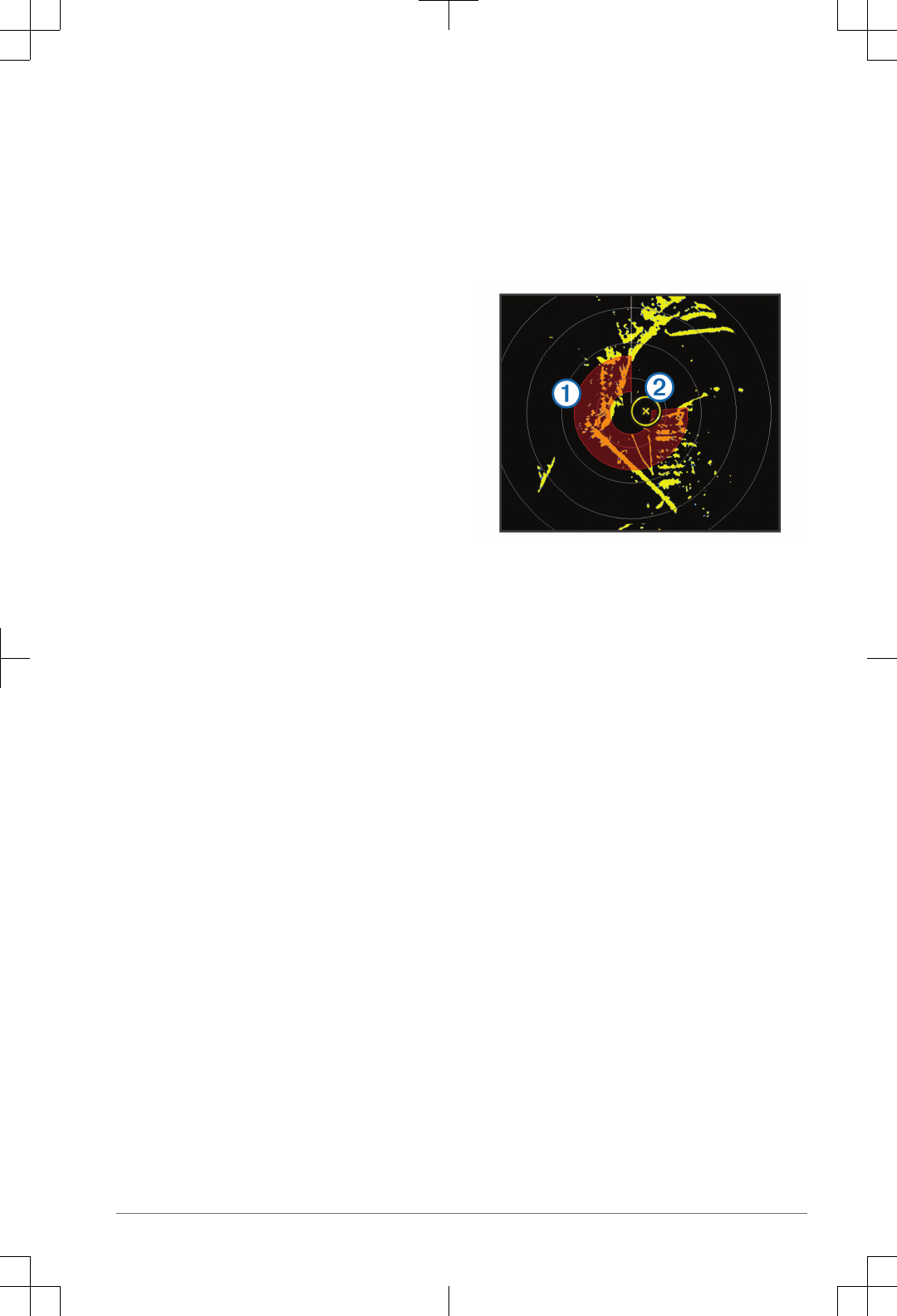
radar. As the range increases, the radar transmits longer
pulses in order to reach distant targets. Closer targets,
especially rain and waves, also reflect the longer pulses,
which can add noise to the Radar screen. Viewing
information about longer-range targets can also decrease the
amount of space available on the Radar screen for viewing
information about shorter-range targets.
• Determine what information you need to see on the
Radar screen.
For example, do you need information about nearby
weather conditions or targets and traffic, or are you more
concerned about distant weather conditions?
• Assess the environmental conditions where the radar is
being used.
Especially in inclement weather, longer-range radar
signals can increase the clutter on the Radar screen and
make it more difficult to view information about shorter-
range targets. In rain, shorter-range radar signals can
enable you to view information about nearby objects more
effectively, if the rain clutter setting is configured
optimally.
• Select the shortest effective range, given your reason for
using radar and the present environmental conditions.
Sentry Mode
Sentry mode allows you to put the radar into timed-transmit
mode, in which you can configure a radar transmit and
standby cycle to conserve power. You can also enable a
guard zone in this mode, which identifies a safe zone around
your boat and sounds an alarm when a radar object enters
the zone. Sentry mode works with all Garmin GMR model
radars.
Enabling Timed Transmit
From the sentry screen, select MENU > Sentry Setup >
Timed Transmit > On.
Setting the Standby and Transmit Times
Before you can set the standby and transmit times, you must
enable timed transmit (page 15).
To help conserve power, you can indicate the radar standby
time and the transmit time to implement periodic radar signal
transmissions at set intervals.
1From the sentry screen, select MENU > Sentry Setup.
2Select Stdby Time.
3Enter the time interval between radar signal
transmissions.
4Select Transmit Time.
5Enter the duration of each radar signal transmission.
Enabling a Guard Zone
From the sentry screen, select MENU > Sentry Setup >
Enable Guard Zone.
Defining a Circular Guard Zone
Before you can define the boundaries of the guard zone, you
must enable a guard zone (page 15).
You can define a circular guard zone that completely
encompasses your boat.
1From the sentry screen, select MENU > Sentry Setup >
Adjust Guard Zone > Move Radar Guard Zone >
Circle.
2Select the location of the outer guard zone circle.
3Select the location of the inner guard zone circle to define
the width of the guard zone.
Defining a Partial Guard Zone
You can define the boundaries of a guard zone that does not
completely encompass your boat.
1From the sentry screen, select MENU > Sentry Setup >
Adjust Guard Zone > Move Radar Guard Zone >
Corner 1.
2Touch and drag the location of the outer guard-zone
corner À.
3Select Corner 2.
4Touch the location of the inner guard-zone corner Á to
define the width of the guard zone.
Marking a Waypoint on the Radar Screen
1From a Radar screen or the Radar overlay, select a
location.
2Select Create Waypoint.
Viewing a List of AIS Threats
From any Radar screen or the Radar overlay, you can view
and customize the appearance of a list of AIS threats.
From a Radar screen or the Radar overlay, select MENU
> Other Vessels > AIS List.
Showing AIS Vessels on the Radar Screen
AIS requires the use of an external AIS device and active
transponder signals from other vessels.
You can configure how other vessels appear on the Radar
screen. If any setting (except the AIS display range) is
configured for one radar mode, the setting is applied to every
other radar mode. The details and projected heading settings
configured for one radar mode are applied to every other
radar mode and to the Radar overlay.
1From a Radar screen or the Radar overlay, select MENU
> Other Vessels > Display Setup.
2Select an option:
•To indicate the distance from your location within
which AIS vessels appear, select AIS Display Range,
and select a distance.
• To show details about AIS-activated vessels, select
Details > Show.
• To set the projected heading time for AIS-activated
vessels, select Projected Heading, and enter the
time.
• To show the tracks of AIS vessels, select Trails, and
select the length of the track that appears.
Radar 15
DRAFT

VRM and EBL
The variable range marker (VRM) and the electronic bearing
line (EBL) measure the distance and bearing from your boat
to a target object. On the Radar screen, the VRM appears as
a circle that is centered on the present location of your boat,
and the EBL appears as a line that begins at the present
location of your boat and intersects the VRM. The point of
intersection is the target of the VRM and the EBL.
Showing the VRM and the EBL
The VRM and the EBL configured for one mode are applied
to all other radar modes.
From a Radar screen, select MENU > Show VRM/EBL.
Adjusting the VRM and the EBL
Before you can adjust the VRM and the EBL, you must show
them on the Radar screen (page 16).
You can adjust the diameter of the VRM and the angle of the
EBL, which moves the intersection point of the VRM and the
EBL. The VRM and the EBL configured for one mode are
applied to all other radar modes.
1From a Radar screen, select a new location for the
intersection point of the VRM and the EBL.
2Select Drop VRM/EBL.
3Select Stop Panning.
Measuring the Range and Bearing to a Target
Object
Before you can adjust the VRM and the EBL, you must show
them on the Radar screen (page 16).
1From a Radar screen, select the target location.
2Select Measure Distance.
The range and the bearing to the target location appear in
the upper-left corner of the screen.
Radar Overlay
When you connect your chartplotter to an optional Garmin
marine radar, you can use the Radar overlay to overlay radar
information on the Navigation chart or on the Fishing chart.
The Radar overlay superimposes radar information on the
Navigation chart or the Fishing chart. Data appears on the
Radar overlay based on the most recently used radar mode
(such as Harbor, Offshore, or Sentry), and all settings
configurations applied to the Radar overlay are also applied
to the last-used radar mode. For example, if you use Harbor
mode and then you switch to the Radar overlay, the Radar
overlay would show Harbor mode radar data. If you changed
the gain setting using the Radar overlay menu, the gain
setting for Harbor mode would change automatically.
Radar Overlay and Chart Data Alignment
When using the Radar overlay, the chartplotter aligns radar
data with chart data based on the boat heading, which is
based by default on data from a magnetic heading sensor
connected using a NMEA 0183 or NMEA 2000 network. If a
heading sensor is not available, the boat heading is based on
GPS tracking data.
GPS tracking data indicates the direction in which the boat is
moving, not the direction in which the boat is pointing. If the
boat is drifting backward or sideways due to a current or
wind, the Radar overlay may not perfectly align with the chart
data. This situation should be avoided by using boat-heading
data from an electronic compass.
If the boat heading is based on data from a magnetic heading
sensor or an automatic pilot, the heading data could be
compromised due to incorrect setup, mechanical malfunction,
magnetic interference, or other factors. If the heading data is
compromised, the Radar overlay may not align perfectly with
the chart data.
Showing the Radar Overlay
The Radar overlay displays data based on the most recently
used radar mode.
From a Radar screen, select MENU > Change Radar >
Radar Overlay.
The radar picture appears in orange and overlays the
Navigation chart.
Stopping the Transmission of Radar
Signals
From a Radar screen, select MENU > Radar to Standby.
Optimizing the Radar Display
You can adjust the radar display settings for reduced clutter
and increased accuracy.
NOTE: You can optimize the radar display for each radar
mode.
1Select a radar range (page 16).
2Restore the default value of the gain setting (page 16).
3Adjust the gain setting manually (page 17).
Range of Radar Signals
The range of the radar signal indicates the length of the
pulsed signal transmitted and received by the radar. As the
range increases, the radar transmits longer pulses in order to
reach distant targets. Closer targets, especially rain and
waves, also reflect the longer pulses, which can add noise to
the Radar screen. Viewing information about longer-range
targets can also decrease the amount of space available on
the Radar screen for viewing information about shorter-range
targets.
Radar Gain and Clutter
Adjusting Gain on the Radar Screen Automatically
The automatic gain setting for each radar mode is optimized
for that mode, and may differ from the automatic gain setting
used for another mode.
NOTE: Depending upon the radar in use, the gain setting
configured for use in one radar mode may or may not be
applied to other radar modes or to the Radar overlay.
NOTE: Not all options and settings are available on all radar
and chartplotter models.
1From a Radar screen or the Radar overlay, select MENU
> Gain.
2Select an available option:
• Select Auto.
The chartplotter sets the gain automatically once,
based on average conditions, the range of the radar
signal, and the selected radar mode. The chartplotter
does not readjust the gain automatically in response
to changing conditions.
• Select Auto Harbor or Auto Offshore.
The chartplotter automatically adjusts the gain for the
conditions.
16 Radar
DRAFT

Adjusting Gain on the Radar Screen Manually
For optimal radar performance, you can manually adjust the
gain.
NOTE: Depending upon the radar in use, the gain setting
configured for use in one radar mode may or may not be
applied to other radar modes or to the Radar overlay.
1From a Radar screen or the Radar overlay, select MENU
> Gain.
2Select Up to raise the gain, until light speckles appear
across the Radar screen.
Data on the Radar screen is refreshed every few
seconds. As a result, the effects of manually adjusting the
gain may not appear instantly. Adjust the gain slowly.
3Select Down to lower the gain until the speckles
disappear.
4If boats, land, or other targets are within range, select
Down to lower the gain until the targets begin to blink.
5Select Up to raise the gain until the boats, land, or other
targets appear steadily lit on the Radar screen.
6Minimize the appearance of nearby large objects, if
necessary.
7Minimize the appearance of side-lobe echoes, if
necessary.
Minimizing Nearby Large-Object Interference
Nearby targets of significant size, such as jetty walls, can
cause a very bright image of the target to appear on the
Radar screen. This image can obscure smaller targets
located near it.
NOTE: Depending upon the radar in use, the gain setting
configured for use in one radar mode may or may not be
applied to other radar modes or to the Radar overlay.
1From a Radar screen or the Radar overlay, select MENU
> Gain.
2Select Down to lower the gain until the smaller targets
are clearly visible on the Radar screen.
Reducing the gain to eliminate nearby large-object
interference may cause smaller or distant targets to blink
or disappear from the Radar screen.
Minimizing Side-Lobe Interference on the Radar Screen
Side-lobe interference may appear to streak outward from a
target in a semi-circular pattern. Side-lobe effects can be
avoided by reducing the gain or reducing the radar range.
NOTE: Depending upon the radar in use, the gain setting
configured for use in one radar mode may or may not be
applied to other radar modes or to the Radar overlay.
1From a Radar screen or the Radar overlay, select MENU
> Gain.
2Select Down to lower the gain until the semi-circular,
streaked pattern disappears from the Radar screen.
Reducing the gain to eliminate side-lobe interference may
cause smaller or distant targets to blink or disappear from
the Radar screen.
Adjusting Sea Clutter on the Radar Screen Automatically
You can set the chartplotter to automatically adjust the
appearance of clutter caused by choppy sea conditions.
NOTE: Depending upon the radar in use, the sea clutter
setting configured for use in one radar mode may or may not
be applied to other radar modes or to the Radar overlay.
NOTE: Not all options and settings are available on all radar
and chartplotter models.
1From a Radar screen or the Radar overlay, select MENU
> Noise Rejection > Sea Clutter.
2Select Presets or Auto.
3Select a setting that reflects the present sea conditions.
When using a compatible radar model, the chartplotter
adjusts the sea clutter based on the sea conditions
automatically..
Adjusting Rain Clutter on the Radar Screen
You can adjust the appearance of clutter caused by rain.
Reducing the radar range also can minimize rain clutter
(page 14).
The rain clutter setting affects the appearance of nearby rain
clutter and targets more than it affects the appearance of
distant rain clutter and targets. A higher rain clutter setting
reduces the appearance of clutter caused by nearby rain, but
it can also reduce or eliminate the appearance of nearby
targets.
NOTE: Depending upon the radar in use, the rain clutter
settings configured for use in one radar mode may or may
not be applied to other radar modes or to the Radar overlay.
1From a Radar screen or the Radar overlay, select MENU
> Noise Rejection > Rain Clutter.
2Select Up or Down to decrease or increase the
appearance of nearby rain clutter until other targets are
clearly visible on the Radar screen.
Clutter caused by rain may still be visible.
Reducing Cross Talk Clutter on the Radar Screen
You can reduce the appearance of clutter caused by
interference from another nearby radar source, when the
cross talk reject setting is on.
NOTE: Depending upon the radar in use, the cross talk reject
setting configured for use in one radar mode may or may not
be applied to other radar modes or to the Radar overlay.
From a Radar screen or the Radar overlay, select MENU
> Noise Rejection > Cross Talk Reject.
Radar Display Settings
From any Radar screen or the Radar overlay, select MENU >
Radar Setup.
Orientation: Sets the perspective of the radar display. The
orientation setting applies to every radar mode. This
setting does not apply to the Radar overlay.
Appearance: Sets the color scheme, look-ahead speed, and
navigation appearance.
Front of Boat: Compensates for the physical location of the
radar scanner on a boat, if the radar scanner does not
align with the bow-stern axis.
Radar Appearance Settings
From a Radar screen, select MENU > Radar Setup >
Appearance.
NOTE: These settings do not apply to the Radar overlay.
Color Scheme: Sets the color scheme.
Look-Ahead Speed: Shifts your present location toward the
bottom of the screen automatically as your speed
increases. Enter your top speed for the best results.
Heading Line: Shows an extension from the bow of the boat
in the direction of travel on the radar screen.
Rings: Shows the range rings that help you to visualize
distances on the radar screen.
Radar 17
DRAFT

Nav. Lines: Shows the navigation lines that indicate the
course you have set using Route To, Guide To, or Go To.
Waypoints: Shows waypoints on the radar screen.
Front-of-Boat Offset
The front-of-boat offset compensates for the physical location
of the radar scanner on a boat, if the radar scanner does not
align with the bow-stern axis.
Measuring the Potential Front-of-Boat Offset
The front-of-boat offset compensates for the physical location
of the radar scanner on a boat, if the radar scanner does not
align with the bow-stern axis.
1Using a magnetic compass, take an optical bearing of a
stationary target located within viewable range.
2Measure the target bearing on the radar.
3If the bearing deviation is more than +/- 1°, set the front-
of-boat offset.
Setting the Front-of-Boat Offset
Before you can set the front-of-boat offset, you must measure
the potential front-of-boat offset.
The front-of-boat offset setting configured for use in one
radar mode is applied to every other radar mode and to the
Radar overlay.
1From a Radar screen or the Radar overlay, select MENU
> Radar Setup > Front of Boat.
2Select Up or Down to adjust the offset.
Digital Selective Calling
Networked Chartplotter and VHF Radio
Functionality
If you have a NMEA 0183 VHF radio or a NMEA 2000 VHF
radio connected to your chartplotter, these features are
enabled.
• The chartplotter can transfer your GPS position to your
radio. If your radio is capable, GPS position information is
transmitted with DSC calls.
• The chartplotter can receive digital selective calling (DSC)
distress and position information from the radio.
• The chartplotter can track the positions of vessels
sending position reports.
If you have a Garmin NMEA 2000 VHF radio connected to
your chartplotter, these features are also enabled.
• The chartplotter allows you to quickly set up and send
individual routine call details to your Garmin VHF radio.
• When you initiate a man-overboard distress call from your
radio, the chartplotter shows the man-overboard screen
and prompts you to navigate to the man-overboard point.
• When you initiate a man-overboard distress call from your
chartplotter, the radio shows the Distress Call page to
initiate a man-overboard distress call.
Turning On DSC
Select Settings > Other Vessels > DSC.
DSC List
The DSC list is a log of the most recent DSC calls and other
DSC contacts you have entered. The DSC list can contain up
to 100 entries. The DSC list shows the most recent call from
a boat. If a second call is received from the same boat, it
replaces the first call in the call list.
Viewing the DSC List
Before you can view the DSC list, the chartplotter must be
connected to a VHF radio that supports DSC.
Select Nav Info > Other Vessels > DSC List.
Adding a DSC Contact
You can add a vessel to your DSC list. You can make calls to
a DSC contact from the chartplotter.
1Select Nav Info > Other Vessels > DSC List > Add
Contact.
2Enter the Maritime Mobile Service Identity (MMSI) of the
vessel.
3Enter the name of the vessel.
Incoming Distress Calls
If your compatible chartplotter and VHF radio are connected
using NMEA 0183 or NMEA 2000, your chartplotter alerts
you when your VHF radio receives a DSC distress call. If
position information was sent with the distress call, that
information is also available and recorded with the call.
designates a distress call in the DSC list and marks the
position of the vessel on the Navigation chart at the time of
the DSC distress call.
Navigating to a Vessel in Distress
designates a distress call in the DSC list and marks the
position of a vessel on the Navigation chart at the time of the
DSC distress call.
1Select Nav Info > Other Vessels > DSC List.
2Select a position-report call.
3Select Navigate To.
4Select Go To or Route To.
Man-Overboard Distress Calls Initiated from a VHF
Radio
When the chartplotter is connected to a compatible VHF
radio with NMEA 2000, and you initiate a man-overboard
DSC distress call from the radio, the chartplotter shows the
man-overboard screen and prompts you to navigate to the
man-overboard point. If you have a compatible autopilot
system connected to the network, the chartplotter prompts
you to start a Williamson’s turn to the man-overboard point.
If you cancel the man-overboard distress call on the radio,
the chartplotter screen prompting you to activate navigation
to the man-overboard location disappears.
Man-Overboard Distress Calls Initiated from the
Chartplotter
When your chartplotter is connected to a Garmin NMEA 2000
compatible radio and you activate navigation to a man-
overboard location, the radio shows the Distress Call page so
you can quickly initiate a man-overboard distress call.
For information on placing distress calls from your radio, see
the VHF radio owner’s manual. For information about
marking an MOB, see page 9.
Position Tracking
When you connect the chartplotter to a VHF radio using
NMEA 0183, you can track vessels that send position
reports. This feature is also available with NMEA 2000, when
18 Digital Selective Calling
DRAFT

the vessel sends the correct PGN data (PGN 129808; DSC
Call Information).
Every position report call received is logged in the DSC list
(page 18).
Viewing a Position Report
1Select Nav Info > Other Vessels > DSC List.
2Select a position-report call.
3Select an option:
• To switch to position report details, select .
• To switch to a Navigation chart marking the location,
select .
• To switch to a Navigation chart marking the location,
select Next Page.
• To view the position report details, select Previous
Page.
Navigating to a Tracked Vessel
1Select Nav Info > Other Vessels > DSC List.
2Select a position-report call.
3Select Navigate To.
4Select Go To or Route To.
Creating a Waypoint at the Position of a Tracked
Vessel
1Select Nav Info > Other Vessels > DSC List.
2Select a position-report call.
3Select Create Waypoint.
Editing Information in a Position Report
1Select Nav Info > Other Vessels > DSC List.
2Select a position-report call.
3Select Edit.
• To enter the name of the vessel, select Name.
• To select a new symbol, select Symbol, if available.
• To enter a comment, select Comment.
• To show a trail line for the vessel if your radio is
tracking the position of the vessel, select Trail.
• To select a color for the trail line, select Trail Line.
Deleting a Position-Report Call
1Select Nav Info > Other Vessels > DSC List.
2Select a position-report call.
3Select Edit > Clear Report.
Viewing Vessel Trails on the Chart
You can view trails for all tracked vessels on some chart
views. By default, a black line indicates the path of the
vessel, a black dot indicates each previously reported
position of a tracked vessel, and a blue flag indicates the last
reported position of the vessel.
1From a chart or 3D chart view, select MENU > Other
Vessels > DSC Trails.
2Select the number of hours to show tracked vessels on
the chart.
For example, if you select 4 Hours, all trail points that are
less than four hours old appear for all tracked vessels.
Individual Routine Calls
When you connect the chartplotter to a Garmin VHF radio
over the NMEA 2000 or the NMEA 0183 network, you can
use the chartplotter interface to set up an individual routine
call.
When setting up an individual routine call from your
chartplotter, you can select the DSC channel on which you
want to communicate. The radio transmits this request with
your call.
Selecting a DSC Channel
NOTE: The selection of a DSC channel is limited to those
channels that are available in all frequency bands. The
default channel is 72. If you select a different channel, the
chartplotter uses that channel for subsequent calls until you
call using another channel.
1Select Nav Info > Other Vessels > DSC List.
2Select a vessel or a station to call.
3Select Call with Radio > Channel.
4Select an available channel.
Making an Individual Routine Call
NOTE: When initiating a call from the chartplotter, if the radio
does not have an MMSI number programmed, the radio will
not receive call information.
1Select Nav Info > Other Vessels > DSC List.
2Select a vessel or a station to call.
3Select Call with Radio.
4If necessary, select Channel, and select a new channel.
5Select Send.
The chartplotter sends information about the call to the
radio.
6On your Garmin VHF radio, select Call.
Making an Individual Routine Call to an AIS Target
1From a chart or 3D chart view, select an AIS target.
2Select AIS Vessel > Call with Radio.
3If necessary, select Channel, and select a new channel.
4Select Send.
The chartplotter sends information about the call to the
radio.
5On your Garmin VHF radio, select Call.
SiriusXM®
WARNING
The weather information provided through this product is
subject to service interruptions and may contain errors,
inaccuracies, or outdated information, and consequently
should not be relied upon exclusively. Always use common
sense while navigating, and check alternate weather
information sources prior to making safety-related decisions.
You acknowledge and agree that you shall be solely
responsible for use of the weather information and all
decisions taken with respect to navigating in weather. Garmin
will not be responsible for any consequences of using
SiriusXM weather information.
NOTE: SiriusXM data is not available in all regions.
SiriusXM®19
DRAFT

A Garmin SiriusXM satellite weather receiver and antenna
receives satellite weather data and shows it on various
Garmin devices, including the Navigation chart on a
compatible chartplotter. The weather data for each feature
comes from reputable weather data centers such as the
National Weather Service and the Hydrometeorological
Prediction Center. For more information, go to
www.siriusxm.com/sxmmarine.
SiriusXM Equipment and Subscription
Requirements
To use satellite weather, you must have a compatible satellite
weather receiver. To use SiriusXM satellite radio, you must
have a compatible satellite radio receiver. Go to
www.garmin.com for more information. You must also have a
valid subscription to receive satellite weather and radio. For
more information, refer to the instructions for your satellite
weather and radio equipment.
Weather Data Broadcasts
Weather data is broadcast at five-minute intervals. When the
Garmin receiver is turned on, or when a different weather
feature is selected, the receiver must receive new data
before it can be shown. You might experience a delay before
weather data or a different feature appears on the chart.
NOTE: Any weather feature can change in appearance if the
source that provides the information changes.
Viewing Precipitation Information
Precipitation ranging from very light rain and snow, up to
strong thunderstorms, is indicated in varying shades and
colors. Precipitation is shown either independently or with
other weather information.
Select Weather > Precipitation.
The time stamp in the upper-left corner of the screen
indicates the elapsed time since the weather data
provider last updated the information.
Precipitation Views
From the precipitation weather chart, select MENU.
Radar Loop: Shows precipitation information as an image of
the latest update or as an animated loop of the latest
updates. The time stamp indicates the elapsed time since
the service provider generated the weather radar frame
currently displayed on the screen.
Cloud Cover: Shows cloud cover data.
Waypoints: Shows waypoints.
Legend: Shows the weather legend.
Storm Cell and Lightning Information
Storm cell icons on the weather Precipitation chart
indicate both the present position of a storm and the
projected path of that storm in the immediate future.
Red cones appear with a storm cell icon, and the widest part
of each cone points in the direction of the projected path of
the storm cell. The red lines in each cone indicate where the
storm will most likely be in the near future. Each line
represents 15 minutes.
Lightning strikes are represented by . Lightning appears on
the weather Precipitation chart if strikes were detected within
the last seven minutes. The ground-based lightning detection
network detects cloud-to-ground lightning only.
Hurricane Information
The weather Precipitation chart can show the present
position of a hurricane , a tropical storm, or a tropical
depression. A red line stemming from a hurricane icon
indicates the projected path of the hurricane. Darkened dots
on the red line indicate the projected locations through which
the hurricane will pass, as received from the weather data
provider.
Weather Warnings and Weather Bulletins
When a marine weather warning, weather watch, weather
advisory, weather bulletin, or other weather statement is
issued, shading indicates the area to which the information
applies. The aqua lines on the chart indicate the boundaries
of marine forecasts, coastal forecasts, and offshore
forecasts. Weather bulletins may consist of either weather
watches or weather advisories.
To view information about the warning or bulletin, select the
shaded area.
Color Marine Weather
Group
Weather Subcategories
Light
Blue
Flash Flood
Dark
Blue
Flood Areal Flood, Coastal Flood, Debris
Flow, Flood, High Water Level,
Hydrological, Lakeshore Flood, Storm
Surge
Yellow Marine/Wind Brisk Wind, Extreme Wind, Freezing
Spray, Gale, Hazardous Seas, High
Surf, High Wind, Hurricane Force
Wind, Lake Wind, Les Suêtes Wind,
Low Water, Marine Weather, Rip
Tide, Small Craft, Small Craft
Hazardous Seas, Small Craft Rough
Bar, Small Craft Winds, Special
Marine, Squall, Storm, Strong Wind,
Tsunami, Waterspout, Wind,
Wreckhouse Winds
Pink Miscellaneous Air Quality, Air Stagnation, Ashfall,
Blowing Dust, Excessive Heat, Fire
Weather, Heat, High Heat and
Humidity, Humidex, Humidex and
Health, Rainfall, Special Weather,
Weather
Orange Severe Storm
Red Tornado
Purple Tropical Hurricane, Inland Hurricane, Inland
Tropical Storm, Tropical Storm,
Typhoon
Dark
Gray
Visibility Dense Fog, Dense Smoke, Dust
Storm, Smog
White Winter Arctic Outflow, Avalanche, Blizzard,
Blowing Snow, Cold Wave, Extreme
Cold, Flash Freeze, Freeze, Freezing
Drizzle, Freezing Fog, Freezing Rain,
Frost, Hard Freeze, Heavy Freezing
Spray, Heavy Snow, Ice Storm, Lake
Effect Blowing Snow, Lake Effect
Snow, Sleet, Snow, Snow and
Blowing Snow, Snow Squall,
Snowfall, Wind Chill, Winter Storm,
Winter Weather
Forecast Information
The Forecast chart shows city forecasts, marine forecasts,
warnings, hurricane warnings, METARS, county warnings,
20 SiriusXM®
DRAFT
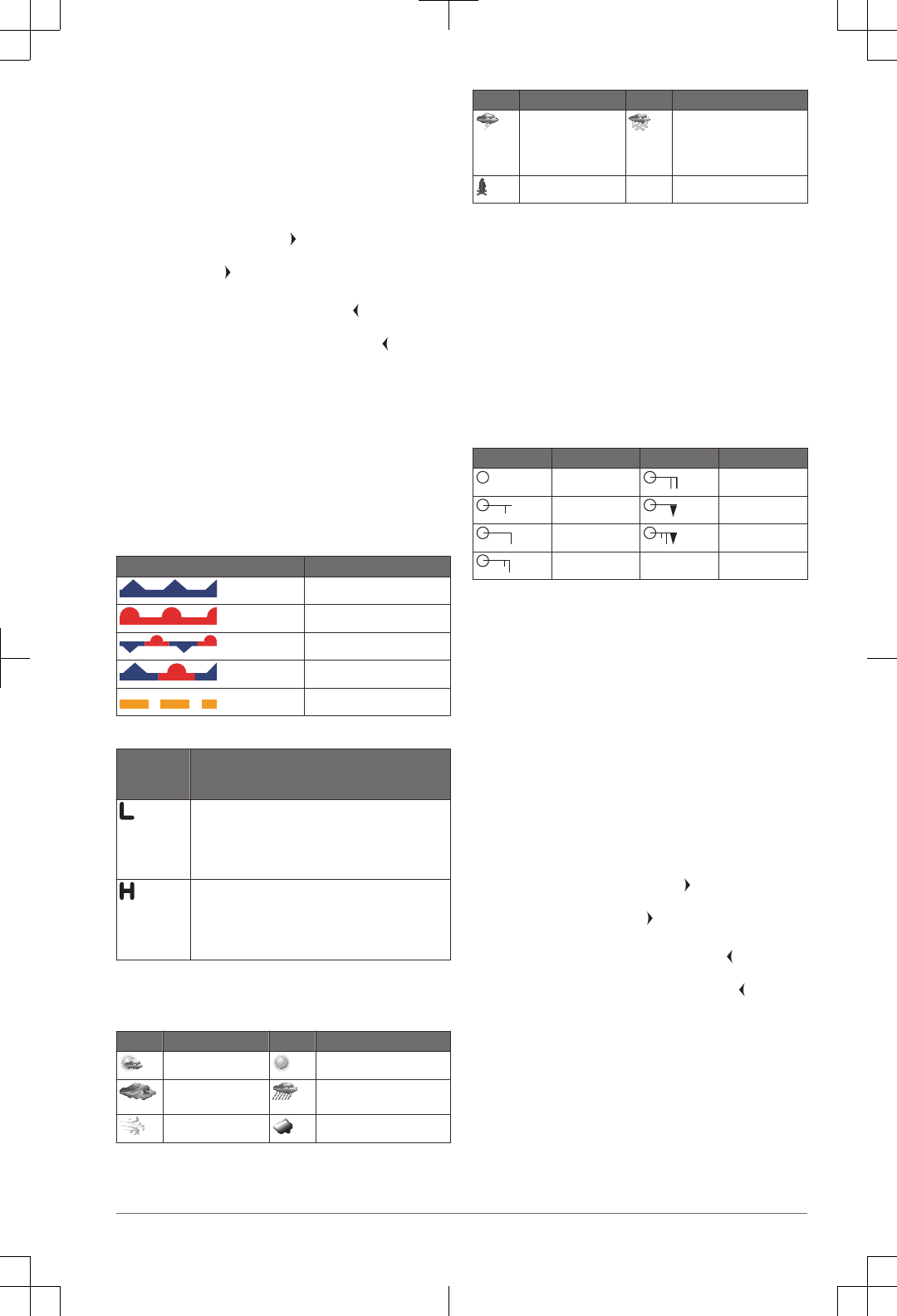
weather fronts and pressure centers, surface pressure, and
weather buoys.
Viewing Forecast Information for Another Time
Period
1Select Weather > Forecast.
2Select an option:
• To view the weather forecast for the next 12 hours,
select Next Forecast or , and to view forecasts up to
48 hours, in 12-hour increments, select Next
Forecast or again.
• To view the weather forecast for the previous 12
hours, select Previous Forecast or , and to view
previous forecasts, up to 48 hours ago, in 12-hour
increments, select Previous Forecast or again.
Viewing a Marine Forecast or an Offshore Forecast
1Select Weather > Forecast.
2Pan the chart to an offshore location.
The Marine Forecast or Offshore Forecast options appear
when forecast information is available.
3Select Marine Forecast or Offshore Forecast.
Weather Fronts and Pressure Centers
Weather fronts appear as lines that indicate the leading edge
of an air mass.
Front Symbol Description
Cold front
Warm front
Stationary front
Occluded front
Trough
Pressure-center symbols often appear near weather fronts.
Pressure-
Center
Symbol
Description
Indicates a low-pressure center, which is a region of
relatively lower pressure. Moving away from a low-
pressure center results in increased pressure.
Winds flow counterclockwise around low-pressure
centers in the northern hemisphere.
Indicates a high-pressure center, which is a region
of relatively higher pressure. Moving away from a
high-pressure center results in decreased pressure.
Winds flow clockwise around high-pressure centers
in the northern hemisphere.
City Forecasts
City forecasts appear as weather symbols. The forecast is
viewed in 12-hour increments.
Symbol Weather Symbol Weather
Partly cloudy Fair (sunny, hot, clear)
Cloudy Rain (drizzle, sleet,
showers)
Windy Foggy
Symbol Weather Symbol Weather
Thunderstorms Snow (snow showers,
flurries, blizzard, blowing
snow, sleet, freezing rain,
freezing drizzle)
Smoke (dusty, hazy)
Viewing Sea Conditions
The Sea Conditions chart shows information about surface
conditions, including winds, wave height, wave period, and
wave direction.
Select Weather > Sea Conditions.
Surface Winds
Surface wind vectors appear on the Sea Conditions chart
using wind barbs that indicate the direction from which the
wind is blowing. A wind barb is a circle with a tail. The line or
flag attached to the tail of the wind barb indicates the wind
speed. A short line represents 5 knots, a long line represents
10 knots, and triangle represents 50 knots.
Wind Barb Wind Speed Wind Barb Wind Speed
Calm 20 knots
5 knots 50 knots
10 knots 65 knots
15 knots
Wave Height, Wave Period, and Wave Direction
Wave heights for an area appear as variations in color.
Different colors indicate different wave heights, as shown in
the legend.
The wave period indicates the time (in seconds) between
successive waves. Wave period lines indicate areas that
have the same wave period.
Wave directions appear on the chart using red arrows. The
direction of each arrow pointer indicates the direction in
which a wave is moving.
Viewing Forecast Sea Conditions Information for
Another Time Period
1Select Weather > Sea Conditions.
2Select an option:
•To view forecasted sea conditions for the next 12
hours, select Next Forecast or , and to view
forecasts up to 48 hours, in 12-hour increments,
select Next Forecast or again.
•To view the forecasted sea conditions for the previous
12 hours, select Previous Forecast or , and to view
previous forecasts, up to 48 hours ago, in 12-hour
increments, select Previous Forecast or again.
Viewing Fishing Information
The weather Fishing chart shows present water temperature,
present surface pressure conditions, and fishing forecasts.
Select Weather > Fishing.
Surface Pressure and Water Temperature Data
Surface-pressure information appears as pressure isobars
and pressure centers. Isobars connect points of equal
pressure. Pressure readings can help to determine weather
and wind conditions. High-pressure areas are generally
associated with fair weather. Low-pressure areas are
SiriusXM®21
DRAFT

generally associated with clouds and the chance of
precipitation. Isobars packed closely together show a strong
pressure gradient. Strong pressure gradients are associated
with areas of stronger winds.
Pressure units are shown in millibars (mb), inches of Mercury
(inHg), or hectopascals (hPa).
Colored shading indicates the surface temperature of the
water, as shown in the legend in the corner of the display.
Forecasting Fish Locations
You can show areas that contain optimal weather conditions
for specific species of fish.
1From the weather Fishing chart, select Weather >
Fishing > MENU > Fish Species.
2Select a species of fish.
3Select On.
4Repeat steps 2 and 3 to show areas with optimal weather
conditions for additional species of fish.
Shaded areas indicate optimal fishing areas. If you have
selected more than one species of fish, you can select a
shaded area to view the fish species that are included in
the shaded area.
Visibility Information
Visibility is the forecast maximum horizontal distance that can
be seen at the surface, as shown in the legend on the left of
the screen. Variations in the visibility shading show the
forecast change in surface visibility.
Select Weather > Visibility.
Viewing Forecast Visibility Information for Another
Time Period
1Select Weather > Visibility.
2Select an option:
• To view the visibility forecast for the next 12 hours,
select Next Forecast or , and to view forecasts up to
48 hours, in 12-hour increments, select Next
Forecast or again.
• To view the visibility forecast for the previous 12
hours, select Previous Forecast or , and to view
previous forecasts, up to 48 hours ago, in 12-hour
increments, select Previous Forecast or again.
Viewing Buoy Reports
Report readings are taken from buoys and coastal
observation stations. These readings are used to determine
air temperature, dew point, water temperature, tide, wave
height and period, wind direction and speed, visibility, and
barometric pressure.
1From a weather chart, select .
2Select Review > Buoy.
Review does not appear if the cursor is not near an
object. If the cursor is near only one object, the name of
the buoy appears.
Viewing Local Weather Information near a Buoy
You can select an area near a buoy to view forecast
information.
1From a weather chart, select a location on the chart.
2Select Local Weather.
3Select an option:
• To view present weather conditions from a local
weather service, select Current Conditions.
• To view a local weather forecast, select Forecast.
• To view surface wind and barometric pressure
information, select Sea Surface.
• To view wind and wave information, select Marine
Bulletin.
Creating a Waypoint on a Weather Chart
1From a weather chart, select a location.
2Select Create Waypoint.
Weather Overlay
The weather overlay superimposes weather and weather-
related information on the Navigation chart, the Fishing chart,
and the Perspective 3D chart view. The Navigation chart and
the Fishing chart can show weather radar, height of cloud
tops, lightning, weather buoys, county warnings, and
hurricane warnings. The Perspective 3D chart view can show
weather radar.
Weather overlay settings configured for use on one chart are
not applied to another chart. The weather overlay settings for
each chart must be configured separately.
NOTE: The offshore Fishing chart is available with premium
charts, in some areas.
Turning On the Weather Overlay on a Chart
From the Navigation chart or Fishing chart, select MENU
> Chart Setup > Weather > Weather > On.
Weather Overlay Settings on the Navigation Chart
From the Navigation chart, select MENU > Chart Setup >
Weather.
Weather: Turns on and off the weather overlay.
Precipitation: Shows precipitation data.
Cloud Cover: Shows cloud cover data.
Satellite IR: Shows infrared satellite data, which displays
clouds based on cloud-top temperatures. Deeper shades
of gray represent colder clouds often found with cirrus or
thunderstorm clouds. Lighter shades or a lack of shading
indicate warmer clouds usually associated with stratus or
fog.
Buoys: Shows weather buoys.
Legend: Shows the weather legend.
Weather Overlay Settings on the Fishing Chart
From the Fishing chart, select MENU > Chart Setup >
Weather.
Precipitation: Shows precipitation radar.
Sea Temperature: Shows sea temperature data.
Buoys: Shows weather buoys.
Legend: Shows the weather legend.
Viewing Weather Subscription Information
You can view information about the weather services you
have subscribed to and how many minutes have passed
since the data for each service was updated.
Select Weather > Weather Subscription.
22 SiriusXM®
DRAFT

SiriusXM Radio
When you have a Garmin SiriusXM receiver connected to the
chartplotter, you may have access to SiriusXM satellite radio,
depending on your subscription.
Customizing the Channel Guide
SiriusXM radio channels are grouped in categories. You can
select the category of channels that appear in the channel
guide.
1Select Media > MENU > Category.
2Select a category.
Saving a SiriusXM Channel to the Presets List
You can save your favorite channels to the presets list.
1Select Media.
2Select the channel you want to save as a preset.
3Select MENU > Presets > Add Current Channel.
Adjusting SiriusXM Satellite Radio Volume
1Select Media > MENU.
2Select or .
Device Configuration
Turning On the Chartplotter Automatically
You can set the chartplotter to turn on automatically when the
power is applied. Otherwise, you must turn on the chartplotter
by pressing .
Select Settings > System > Auto Power.
NOTE: When Auto Power is On, and the chartplotter is
turned off using , and power is removed and reapplied
within less than two minutes, you may need to press to
restart the chartplotter.
System Settings
Select Settings > System.
Display: Adjusts the backlight brightness and color scheme.
Beeper: Turns on and off the tone that sounds for alarms and
selections.
GPS: Provides information about the GPS satellite settings
and fix.
Auto Power: Turns the device on automatically when power
is applied (page 23).
Language: Sets the on-screen text language.
Speed Sources: Sets the source of the speed data used to
calculate true wind speed or fuel economy. Water speed
is the speed reading from a water-speed sensor, and
GPS speed is calculated from your GPS position.
System Information: Provides information about the device
and the software version.
Simulator: Turns the simulator on or off and allows you to
set the speed and simulated location.
GPS Settings
Select Settings > System > GPS.
Skyview: Shows the relative position of GPS satellites in the
sky.
GLONASS: Turns on or off GLONASS usage (Russia
satellite system). When the system is used in situations
with poor sky visibility, this configuration can be used in
combination with GPS to provide more accurate position
information.
WAAS/EGNOS: Turns on or off WAAS (in North America) or
EGNOS (in Europe), which can provide more-accurate
GPS position information. When using WAAS or EGNOS,
the device may take longer to acquire satellites.
Speed Filter: Averages the speed of your vessel over a short
period of time for smoother speed values.
Viewing the Event Log
The event log shows a list of system events.
Select Settings > System > System Information >
Event Log.
Viewing System Software Information
You can view the software version, the basemap version, any
supplemental map information (if applicable), the software
version for an optional Garmin radar (if applicable), and the
unit ID number. You may need this information to update the
system software or to purchase additional map data
information.
Select Settings > System > System Information >
Software Information.
My Vessel Settings
NOTE: Some settings and options require additional charts
or hardware.
Select Settings > My Vessel.
Keel Offset: Offsets the surface reading for the depth of a
keel, making it possible to measure depth from the
bottom of the keel instead of from the transducer location
(page 23).
Temp. Offset: Compensates for the water temperature
reading from a NMEA 0183 water-temperature sensor or
a temperature-capable transducer (page 24).
Calibrate Water Speed: Calibrates the speed-sensing
transducer or sensor (page 24).
Fuel Capacity: Sets the combined fuel capacity of all the fuel
tanks on your vessel (page 13).
Vessel Type: Enables some chartplotter features based on
the boat type.
Fill Up All Tanks: Sets the tank levels to full (page 13).
Add Fuel to Boat: Allows you to enter the quantity of fuel
you added to your tank, when you did not entirely fill up
the tank (page 13).
Set Total Fuel Onboard: Sets the combined amount of fuel
in all the fuel tanks on your vessel (page 13).
Set Gauge Limits: Sets the upper and lower limits of various
gauges (page 12).
Setting the Keel Offset
You can enter a keel offset to compensate the surface
reading for the depth of a keel, making it possible to measure
depth from the bottom of the keel instead of from the
transducer location. Enter a positive number to offset for a
keel. You can enter a negative number to compensate for a
large vessel that may draw several feet of water.
1Complete an action, based on the location of the
transducer:
• If the transducer is installed at the water line À,
measure the distance from the transducer location to
Device Configuration 23
DRAFT
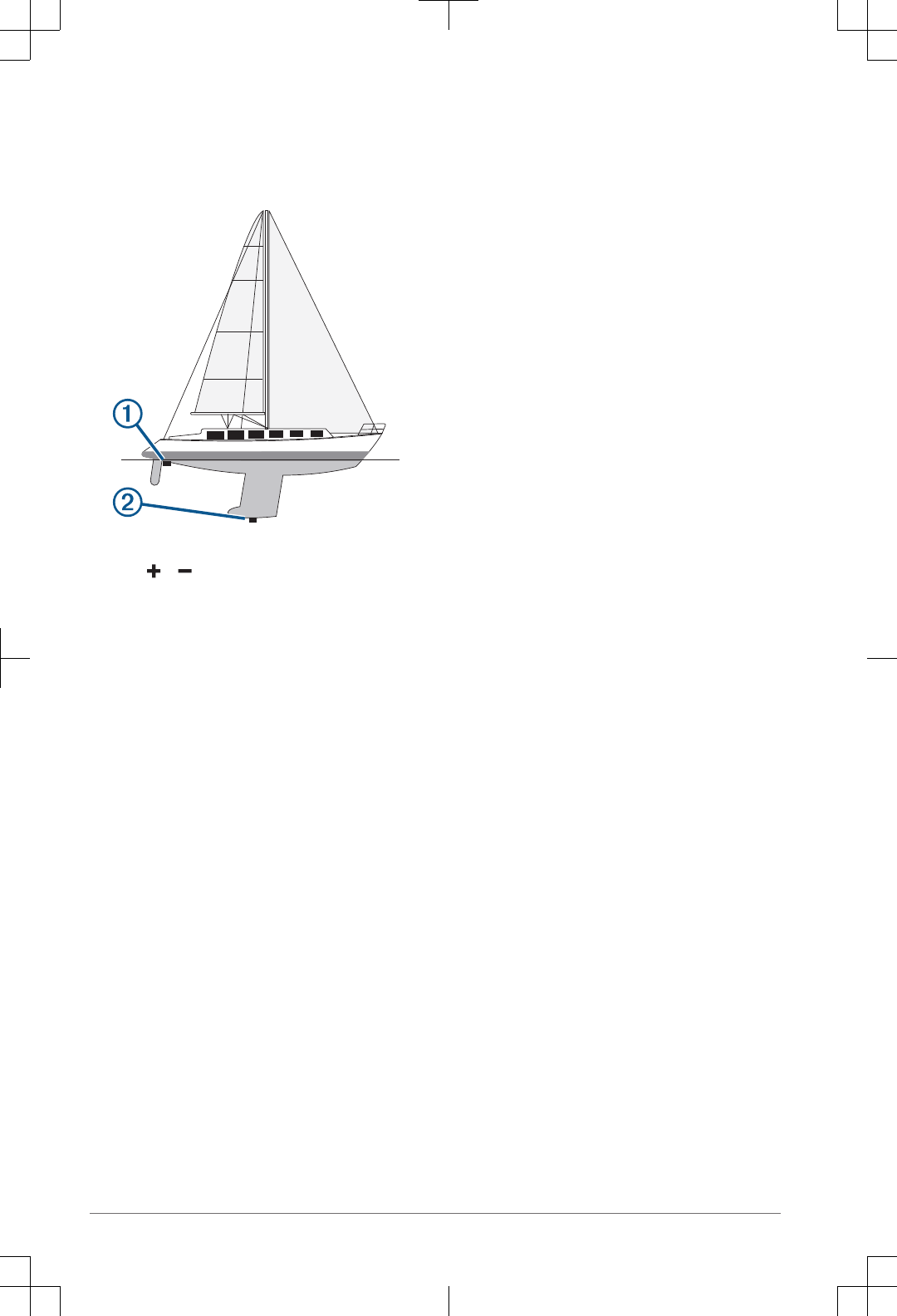
the keel of the boat. Enter this value in steps 3 and 4
as a positive number.
• If the transducer is installed at the bottom of the keel
Á, measure the distance from the transducer to the
water line. Enter this value in steps 3 and 4 as a
negative number.
2Select Settings > My Vessel > Keel Offset.
3Select or based on the location of the transducer.
4Enter the distance measured in step 1.
Setting the Water Temperature Offset
Before you can set the water temperature offset, you must
have a NMEA 0183 water-temperature sensor or a
temperature-capable transducer to measure water
temperature.
The temperature offset compensates for the temperature
reading from a temperature sensor.
1Measure the water temperature using the temperature
sensor or temperature-capable transducer that is
connected to the chartplotter.
2Measure the water temperature using a different
temperature sensor or a thermometer that is known to be
accurate.
3Subtract the water temperature measured in step 1 from
the water temperature measured in step 2.
This is the temperature offset. Enter this value in step 5
as a positive number if the sensor connected to the
chartplotter measures the water temperature as being
colder than it actually is. Enter this value in step 5 as a
negative number if the sensor connected to the
chartplotter measures the water temperature as being
warmer than it actually is.
4Select Settings > My Vessel > Temp. Offset.
5Enter the temperature offset calculated in step 3.
Calibrating a Water Speed Device
If you have a speed-sensing transducer connected to the
chartplotter, you can calibrate that speed-sensing device to
improve the accuracy of water-speed data displayed by the
chartplotter.
1Select Settings > My Vessel > Calibrate Water Speed.
2Follow the on-screen instructions.
If the boat is not moving fast enough or the speed sensor
is not registering a speed, a message appears.
3Select OK, and safely increase the boat speed.
4If the message appears again, stop the boat, and ensure
the speed-sensor wheel is not stuck.
5If the wheel turns freely, check the cable connections.
6If you continue to get the message, contact Garmin
product support.
Communications Settings
NOTE: Some settings and options require additional charts
or hardware.
Select Settings > Communications.
Serial Port 1: Sets the input/output format for port 1 to use
when connecting the chartplotter to external NMEA
devices, computers, or other Garmin devices.
Serial Port 2: Sets the input/output format for port 2 to use
when connecting the chartplotter to external NMEA
devices, computers, or other Garmin devices.
NMEA 0183 Setup: Sets the NMEA 0183 sentences the
chartplotter transmits, how many digits to the right of the
decimal point are transmitted in a NMEA output, and how
waypoints are identified (page 24).
NMEA 2000: Allows you to view and label the devices on the
NMEA 2000 network ().
Marine Network: Allows you to view the devices with which
you are sharing maps, sonar, or radar.
NOTE: You can only view networked data on a model
that supports that data. For example, you cannot view
networked radar on an echoMAP™ 50 model, because
that model does not support radar.
Wi-Fi® Network: Allows you set up wireless devices ().
NMEA 0183
The chartplotters support the NMEA 0183 standard, which is
used to connect various NMEA 0183 devices, such as VHF
radios, NMEA instruments, autopilots, wind sensors, and
heading sensors.
To connect the chartplotter to optional NMEA 0183 devices,
see the chartplotter installation instructions.
The approved NMEA 0183 sentences for the chartplotter are
GPAPB, GPBOD, GPBWC, GPGGA, GPGLL, GPGSA,
GPGSV, GPRMB, GPRMC, GPRTE, GPVTG, GPWPL,
GPXTE, and Garmin proprietary sentences PGRME,
PGRMM, and PGRMZ.
This chartplotter also includes support for the WPL sentence,
DSC, and sonar NMEA 0183 input with support for the DPT
(depth) or DBT, MTW (water temperature), and VHW (water
temperature, speed, and heading) sentences.
NMEA 0183 Settings
Select Settings > Communications > NMEA 0183 Setup.
Sounder: Enables NMEA 0183 output sentences for the
sounder (if applicable).
Route: Enables NMEA 0183 output sentences for routes.
System: Enables NMEA 0183 output sentences for system
information.
Garmin: Enables NMEA 0183 output sentences for Garmin
proprietary sentences.
Posn Precision: Adjusts the number of digits to the right of
the decimal point for transmission of NMEA output.
24 Device Configuration
DRAFT

Waypoint IDs: Sets the device to transmit waypoint names
or numbers via NMEA 0183 while navigating. Using
numbers may resolve compatibility issues with older
NMEA 0183 autopilots.
Diagnostics: Displays NMEA 0183 diagnostic information.
Defaults: Restores the NMEA 0183 settings to the original
factory defaults.
Viewing a List of NMEA 2000 Network Devices
You can view the devices connected to the NMEA 2000
network.
Select Settings > Communications > NMEA 2000
Setup > Device List.
Setting Up the Wireless Network
The chartplotters can create a wireless network to which you
can connect wireless devices. The first time you access the
wireless network settings, you are prompted to set up the
network.
1Select Settings > Communications > Wi-Fi® Network
> Wi-Fi® Connect > On > OK.
2If necessary, enter a name for this wireless network.
3Enter a password.
You will need this password to access the wireless
network from a wireless device. The password is case-
sensitive.
Connecting a Wireless Device to the Chartplotter
Before you can connect a wireless device to the chartplotter
wireless network, you must configure the chartplotter wireless
network (page 25).
You can connect up to five wireless devices to the
chartplotter to share data. For example, you can connect an
iOS® device to the chartplotter to share BlueChart Mobile
data.
1From the iOS device, select Settings > Wi-Fi.
2Select the wireless network name you entered for the
chartplotter network (page 25).
3Enter the password you entered when you set up the
chartplotter as a wireless network.
Changing the Wireless Channel
You might need to change the wireless channel if you have
trouble finding or connecting to a device, or if you experience
interference.
1Select Settings > Communications > Wi-Fi® Network
> Advanced > Wireless Channel.
2Enter a new channel.
You do not need to change the wireless channel in any
devices connected to this network.
Setting Alarms
Navigation Alarms
Select Settings > Alarms > Navigation.
Arrival: Sets an alarm to sound when you are within a
specified distance or time from a turn or a destination.
Anchor Drag: Sets an alarm to sound when you exceed a
specified drift distance while anchored.
Off Course: Sets an alarm to sound when you are off course
by a specified distance.
System Alarms
Alarm Clock: Sets an alarm clock.
Device Voltage: Sets an alarm to sound when the battery
reaches a specified low voltage.
GPS Accuracy: Sets an alarm to sound when the GPS
location accuracy falls outside the user-defined value.
Setting the Fuel Alarm
Before you can set a fuel level alarm, a compatible fuel flow
sensor must be connected to the NMEA 2000 network.
You can set an alarm to sound when the total amount of
remaining onboard fuel reaches the level you specify.
1Select Settings > Alarms > Fuel > Fuel Alarm > On.
2Enter the remaining amount of fuel that triggers the alarm.
Setting Weather Alarms
Before you can set weather alarms, you must have a
compatible chartplotter connected to a weather device, such
as a GXM™ device, and have a valid weather subscription.
1Select Settings > Alarms > Weather.
2Turn on alarms for specific weather events.
Units Settings
Select Settings > Units.
System Units: Sets the unit format for the device.
Heading: Sets the direction references used in calculating
heading information. Auto Mag Var (automatic magnetic
variation) sets the magnetic declination for your location
automatically. True sets true north as the heading
reference. Grid sets grid north as the heading reference
(000º). User Mag Var allows you to enter the magnetic
variation value manually.
Position Format: Sets the position format in which a given
location reading appears. Do not change this setting
unless you are using a map or chart that specifies a
different position format.
Map Datum: Sets the coordinate system on which the map is
structured. Do not change this setting unless you are
using a map or chart that specifies a different map datum.
Pressure Ref. Time: Sets the reference time used to
calculate the barometer trend. The trend is indicated in
the barometer field.
Time Format: Sets a 12-hour, 24-hour, or UTC time format.
Time Zone: Sets the time zone, or allows automatic selection
based on GPS location.
Navigation Settings
NOTE: Some settings and options require additional charts
or hardware.
Select Settings > Navigation.
Route Labels: Sets the type of labels shown with route turns
on the map.
Auto Guidance: Sets the measurements for the Safe Depth,
Safe Height, and Shoreline Distance, when you are
using some premium maps.
Turn Transition Activ.: Sets the turn transition to be
calculated based on time or distance.
Turn Transition Time: Sets how many minutes before the
turn that you transition to it as the next leg, when Time is
selected for the Turn Transition Activ.. You can raise
Device Configuration 25
DRAFT

this value to help improve the accuracy of the autopilot
when navigating a route or an Auto Guidance line with
many frequent turns or at higher speeds. For straighter
routes or slower speeds, lowering this value can improve
autopilot accuracy.
Turn Transition Dist.: Sets how far before the turn that you
transition to it as the next leg, when Distance is selected
for the Turn Transition Activ.. You can raise this value
to help improve the accuracy of the autopilot when
navigating a route or an Auto Guidance line with many
frequent turns or at higher speeds. For straighter routes
or slower speeds, lowering this value can improve
autopilot accuracy.
Route Start: Selects a starting point for route navigation.
Auto Guidance Line Configurations
CAUTION
The Safe Depth and Safe Height settings influence how the
chartplotter calculates an Auto Guidance line. If an area has
an unknown water depth or an unknown obstacle height, the
Auto Guidance line is not calculated in that area. If an area at
the beginning or the end of an Auto Guidance line is
shallower than the safe water depth or lower than the safe
obstacle height, the Auto Guidance line is not calculated in
that area. On the chart, the course through those areas
appears as a gray line. When your boat enters one of those
areas, a warning message appears.
NOTE: Auto Guidance is available with premium charts, in
some areas.
You can set the parameters the chartplotter uses when
calculating an Auto Guidance line.
Safe Depth: Sets the minimum depth (chart depth datum) the
chartplotter uses when calculating an Auto Guidance line.
NOTE: The minimum safe depth for the premium charts
is 3 feet. If you enter a Safe Depth value of less than 3
feet, the charts only use depths of 3 feet for Auto
Guidance route calculations.
Safe Height: Sets the minimum height (chart height datum)
of a bridge that your boat can safely travel under.
Shoreline Distance: Sets how close to the shore you want
the Auto Guidance line to be placed. The Auto Guidance
line may move if you change this setting while navigating.
The available values for this setting are relative, not
absolute. To ensure that the Auto Guidance line is placed
the appropriate distance from shore, you can assess the
placement of the Auto Guidance line using one or more
familiar destinations that require navigation through a
narrow waterway (page 26).
Adjusting the Distance from Shore
CAUTION
The Auto Guidance feature is based on electronic chart
information. That data does not ensure obstacle and bottom
clearance. Carefully compare the course to all visual
sightings, and avoid any land, shallow water, or other
obstacles that may be in your path.
NOTE: Auto Guidance is available with premium charts, in
some areas.
The Shoreline Distance setting indicates how close to the
shore you want the Auto Guidance line to be placed. The
Auto Guidance line may move if you change this setting while
navigating. The available values for the Shoreline Distance
setting are relative, not absolute. To ensure the Auto
Guidance line is placed the appropriate distance from shore,
you can assess the placement of the Auto Guidance line
using one or more familiar destinations that require
navigation through a narrow waterway.
1Dock your vessel or drop the anchor.
2Select Settings > Navigation > Auto Guidance >
Shoreline Distance > Normal.
3Select a destination that you have navigated to
previously.
4Select Navigate To > Guide To.
5Review the placement of the Auto Guidance line, and
determine whether the line safely avoids known obstacles
and the turns enable efficient travel.
6Select an option:
• If the placement of the Auto Guidance line is
satisfactory, select MENU > Stop Navigation, and
proceed to step 10.
• If the Auto Guidance line is too close to known
obstacles, select Settings > Navigation > Auto
Guidance > Shoreline Distance > Far.
• If the turns in the Auto Guidance line are too wide,
select Settings > Navigation > Auto Guidance >
Shoreline Distance > Near.
7If you selected Near or Far in step 6, review the
placement of the Auto Guidance line, and determine
whether the line safely avoids known obstacles and the
turns enable efficient travel.
Auto Guidance maintains a wide clearance from
obstacles in open water, even if you set the Shoreline
Distance setting to Near or Nearest. As a result, the
chartplotter may not reposition the Auto Guidance line,
unless the destination selected requires navigation
through a narrow waterway.
8Select an option:
• If the placement of the Auto Guidance line is
satisfactory, select MENU > Stop Navigation, and
proceed to step 10.
• If the Auto Guidance line is too close to known
obstacles, select Settings > Navigation > Auto
Guidance > Shoreline Distance > Farthest.
• If the turns in the Auto Guidance line are too wide,
select Settings > Navigation > Auto Guidance >
Shoreline Distance > Nearest.
9If you selected Nearest or Farthest in step 8, review the
placement of the Auto Guidance line, and determine
whether the line safely avoids known obstacles and the
turns enable efficient travel.
Auto Guidance maintains a wide clearance from
obstacles in open water, even if you set the Shoreline
Distance setting to Near or Nearest. As a result, the
chartplotter may not reposition the Auto Guidance line,
unless the destination selected requires navigation
through a narrow waterway.
10 Repeat steps 3 through 9 at least once more, using a
different destination each time, until you are familiar with
the functionality of the Shoreline Distance setting.
26 Device Configuration
DRAFT

Other Vessel Settings
When your compatible chartplotter is connected to an AIS
device or VHF radio, you can set up how other vessels are
displayed on the chartplotter.
Select Settings > Other Vessels.
AIS: Enables and disables AIS signal reception.
DSC: Enables and disables digital selective calling (DSC).
AIS Alarm: Sets the collision alarm (page 5 and page 5).
Viewing System Software Information
You can view the software version, the basemap version, any
supplemental map information (if applicable), the software
version for an optional Garmin radar (if applicable), and the
unit ID number. You may need this information to update the
system software or to purchase additional map data
information.
Select Settings > System > System Information >
Software Information.
Restoring the Original Chartplotter Factory
Settings
NOTE: This will delete all settings information you have
entered.
Select Settings > System > System Information >
Factory Settings.
Chartplotter Data Management
Copying Waypoints, Routes, and Tracks to
a Chartplotter
Before you can copy data to the chartplotter, you must have
the latest version of MapSource® or HomePort™ software
programs loaded on your computer and a memory card
installed in the chartplotter.
Select an option:
• Copy the data from HomePort to the prepared
memory card.
For more information, see the HomePort help file.
• Copy the data from MapSource to the prepared
memory card.
For more information, see the MapSource help file.
Copying Data from a Memory Card
1Insert a memory card into a card slot.
2Select Nav Info > Manage Data > Data Transfer > Card.
3If necessary, select the memory card to copy data to.
4Select an option:
• To transfer data from the memory card to the
chartplotter and combine it with existing user data,
select Merge from Card.
• To transfer data from the memory card to the
chartplotter and overwrite existing user data, select
Replace from Card.
5Select the file name.
Copying Waypoints, Routes, and Tracks to
a Memory Card
1Insert a memory card into the card slot.
2Select Nav Info > Manage Data > Data Transfer > Card
> Save to Card.
3If necessary, select the memory card to copy data to.
4Select an option:
• To create a new file, select Add New File, and enter
a name. The file name is saved with an .adm
extension.
• To add the information to an existing file, select the
file from the list.
Copying Waypoints, Routes, and Tracks to
or from all Chartplotters on the Network
You can transfer information for waypoints, routes, and tracks
from one chartplotter connected to the Garmin Marine
Network to every other chartplotter connected to the network.
The transfer may take a long time, depending on the number
of waypoints being transferred.
1Select Nav Info > Manage Data > Data Transfer >
NNew Waypointetwork.
2Select an option:
• To transfer data from the chartplotter to the other
chartplotters connected to the network, select Clone
User Data. Existing data is overwritten on those
chartplotters.
• To transfer data between all the chartplotters
connected to the network, select Merge User Data.
Unique data is combined with existing data on every
chartplotter.
Copying Built-In Maps to a Memory Card
You can copy maps from the chartplotter to a memory card
for use with HomePort.
1Insert a memory card into the card slot.
2Select Nav Info > Manage Data > Data Transfer > Card.
3To copy the maps loaded onto your chartplotter to the
memory card, select Copy Built-In Map.
Backing Up Data to a Computer
1Insert a memory card into the card slot.
2Select Nav Info > Manage Data > Data Transfer > Card
> Save to Card.
3Select a file name from the list, or select Add New File.
4Select Save to Card.
The file name saves with a .adm extension.
5Remove the memory card and insert it into a card reader
attached to a computer.
6Open the Garmin\UserData folder on the memory card.
7Copy the backup file on the card and paste it to any
location on the computer.
Restoring Backup Data to a Chartplotter
1Insert a memory card into a card reader that is attached
to the computer.
2Copy a backup file from the computer to the memory
card, into a folder named Garmin\UserData.
Chartplotter Data Management 27
DRAFT

3Insert a memory card into the card slot.
4Select Nav Info > Manage Data > Data Transfer > Card
> Replace from Card.
Saving System Information to a Memory
Card
You can save system information to a memory card as a
troubleshooting tool. A product support representative may
ask you to use this information to retrieve data about the
network.
1Insert a memory card into the card slot.
2Select Settings > System > System Information >
Garmin Devices > Save to Card.
3If necessary, select the memory card to save system
information to.
4Remove the memory card.
Appendix
Registering Your Device
Help us better support you by completing our online
registration today.
•Go to http://my.garmin.com.
• Keep the original sales receipt, or a photocopy, in a safe
place.
Loading the New Software on a Memory
Card
The device may contain a software-update memory card. If
so, follow the instructions provided with the card. If a software
update memory card is not included, you must copy the
software update to a memory card.
1Insert a memory card into the card slot on the computer.
2Go to www.garmin.com/support/software/marine.html.
3Select Download next to “Garmin Marine Network with
SD card.”
4Read and agree to the terms.
5Select Download.
6Select Run.
7Select the drive associated with the memory card, and
select Next > Finish.
Updating the Device Software
Before you can update the software, you must obtain a
software-update memory card or load the latest software onto
a memory card.
1Turn on the chartplotter.
2Insert the memory card into the card slot.
3Follow the on-screen instructions.
4Wait several minutes while the software update process
completes.
The device returns to normal operation after the software
update process is complete.
5Remove the memory card.
Screenshots
You can capture a screenshot of any screen shown on your
chartplotter as a bitmap (.bmp) file. You can transfer the
screenshot to your computer.
Capturing Screenshots
1Insert a memory card into the card slot.
2Select Settings > System > Display > Screenshot
Capture > On.
3Go to a screen you want to capture.
4Hold HOME for at least six seconds.
Copying Screenshots to a Computer
1Remove the memory card from the chartplotter, and
insert it into a card reader that is attached to a computer.
2From Windows® Explorer, open the Garmin\scrn folder
on the memory card.
3Copy a .bmp file from the card and paste it to any location
on the computer.
NMEA 0183 Information
Type Sentence Description
Transmit GPAPB APB: Heading or track
controller (autopilot) sentence
"B"
GPBOD BOD: Bearing (origin to
destination)
GPBWC BWC: Bearing and distance to
waypoint
GPGGA GGA: Global positioning
system fix data
GPGLL GLL: Geographic position
(latitude and longitude)
GPGSA GSA: GNSS DOP and active
satellites
GPGSV GSV: GNSS satellites in view
GPRMB RMB: Recommended minimum
navigation information
GPRMC RMC: Recommended minimum
specific GNSS data
GPRTE RTE: Routes
GPVTG VTG: Course over ground and
ground speed
GPWPL WPL: Waypoint location
GPXTE XTE: Cross track error
PGRME E: Estimated error
PGRMM M: Map datum
PGRMZ Z: Altitude
SDDBT DBT: Depth below transducer
SDDPT DPT: Depth
SDMTW MTW: Water temperature
SDVHW VHW: Water speed and
heading
Receive DPT Depth
DBT Depth below transducer
MTW Water temperature
VHW Water speed and heading
WPL Waypoint location
28 Appendix
DRAFT
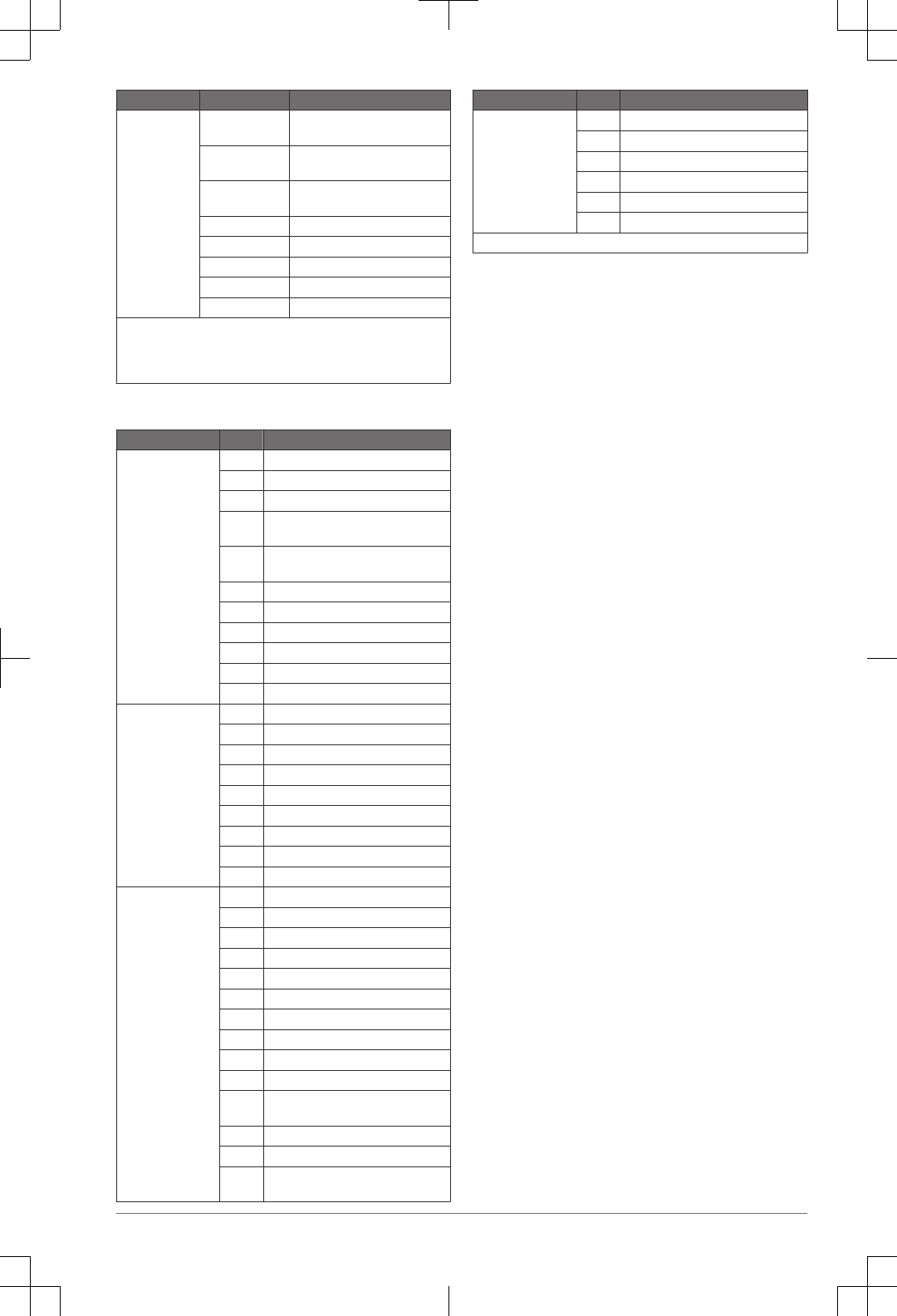
Type Sentence Description
DSC Digital selective calling
information
DSE Expanded digital selective
calling
HDG Heading, deviation, and
variation
HDM Heading, magnetic
MWD Wind direction and speed
MDA Meteorological composite
MWV Wind speed and angle
VDM AIS VHF data-link message
You can purchase complete information about National Marine
Electronics Association (NMEA) format and sentences from: NMEA,
Seven Riggs Avenue, Severna Park, MD 21146 USA
(www.nmea.org)
NMEA 2000 PGN Information
Type PGN Description
Transmit and
receive
059392 ISO acknowledgment
059904 ISO request
060928 ISO address claim
126208 NMEA: Command, request, and
acknowledge group function
126464 Transmit and receive PGN list group
function
126996 Product information
127250 Vessel heading
128259 Speed: Water referenced
128267 Water depth
130306 Wind data
130312 Temperature
Transmit 127258 Magnetic Variance
129025 Position: Rapid update
129026 COG and SOG: Rapid update
129029 GNSS position data
129283 Cross track error
129284 Navigation data
129285 Navigation route and waypoint info
129539 GNSS DOPs
129540 GNSS satellites in view
Receive 127245 Rudder
127250 Vessel heading
127488 Engine parameters: Rapid update
127489 Engine parameters: Dynamic
127493 Transmission parameters: Dynamic
127498 Engine parameters: Static
127505 Fluid level
129038 AIS class A position report
129039 AIS class B position report
129040 AIS class B extended position report
129794 AIS class A static and voyage related
data
129798 AIS SAR aircraft position report
129799 Radio frequency, mode, and power
129802 AIS safety-related broadcast
message
Type PGN Description
129808 DSC call information
130310 Environmental parameters
130311 Environmental parameters (obsolete)
130313 Humidity
130314 Actual pressure
130576 Small craft status
This data applies only to NMEA 2000-compatible products.
Software License Agreement
BY USING THE DEVICE, YOU AGREE TO BE BOUND BY
THE TERMS AND CONDITIONS OF THE FOLLOWING
SOFTWARE LICENSE AGREEMENT. PLEASE READ THIS
AGREEMENT CAREFULLY.
Garmin Ltd. and its subsidiaries (“Garmin”) grant you a
limited license to use the software embedded in this device
(the “Software”) in binary executable form in the normal
operation of the product. Title, ownership rights, and
intellectual property rights in and to the Software remain in
Garmin and/or its third-party providers.
You acknowledge that the Software is the property of Garmin
and/or its third-party providers and is protected under the
United States of America copyright laws and international
copyright treaties. You further acknowledge that the
structure, organization, and code of the Software, for which
source code is not provided, are valuable trade secrets of
Garmin and/or its third-party providers and that the Software
in source code form remains a valuable trade secret of
Garmin and/or its third-party providers. You agree not to
decompile, disassemble, modify, reverse assemble, reverse
engineer, or reduce to human readable form the Software or
any part thereof or create any derivative works based on the
Software. You agree not to export or re-export the Software
to any country in violation of the export control laws of the
United States of America or the export control laws of any
other applicable country.
Appendix 29
DRAFT

Index
A
aerial photos 4
AIS 4–6
alarm 5
distress signal device 5
radar 15
SART 5
targeting 4, 5
threats 5, 15
turning on 27
vessels 5
alarms 25
anchor drag 25
arrival 25
collision 5
engine 12
gauges 12
navigation 25
off course 25
weather 25
anchor drag alarm 25
animated currents, tides 3
arrival alarm 25
Auto Guidance 8, 25
line 26
shoreline distance 26
autopilot 8
B
backlight 1
buoy reports 22
C
celestial information 14
charts 1, 4, 6
appearance 7
details 2
heading line 7
navigation 3, 4
orientation 7
panning 2
symbols 2
clock 25
alarm 25
collision alarm 5
color mode 1
combinations 11, 12
customizing 11, 12
selecting 11
compass 12
compass rose 6
compass tape data bar 6
courses 8
current stations 13, 14
indicators 4
D
data
backup 27
copying 27
data fields 6
data management 27
deleting, all user data 11
destinations
navigation chart 8
selecting 8
device
keys 1, 2
registration 28
digital selective calling 18, 19
channels 19
contacts 18
individual routine call 19
individual routine calls 19
turning on 18, 27
distress call 18
distress signal device 5
DSC. See digital selective calling
E
EBL 16
adjusting 16
measuring 16
showing 16
EGNOS 23
engine gauges 12
configuring 12
status alarms 12
environment gauges 13
environmental gauges 13
EPIRB 5
event log 23
F
factory settings 27
Fish Eye 3D
sonar cone 7
suspended targets 7
tracks 7
fishing chart 2, 22
panning 2
setup 6
fuel alarm 13, 25
fuel capacity 13, 23
fuel gauges 12, 13
configuring 12
status alarm 13, 25
synchronizing with actual fuel 13
fuel onboard 23
G
gauges
engine 12
environment 13
environmental data 13
fuel 12, 13
limits 12
status alarms 12
trip 12
wind 13
GLONASS 23
Go To 8
GPS
EGNOS 23
GLONASS 23
signals 1
WAAS 23
GPS accuracy 25
H
hazard colors 7
home screen, customizing 1
K
keel offset 23
keys 1
power 1
L
lane width 7
language 23
M
man overboard 9
marine services 8
mark location 9
memory card 27, 28
detailed maps 27
installing 1
MOB, device 5
music player 20, 23
N
navaids 3
navigation alarms 25
navigation chart 2, 4, 8, 22
aerial photos 6
marine service points 8
panning 2
radar overlay 16
setup 6
vessel trails 6, 19
navigation inset 6, 7
NMEA 0183 18, 24, 28
NMEA 2000 18, 24, 25, 29
O
off course alarm 25
offset, front of boat 18
other vessels
AIS 6
trails 6
overlay numbers 6
P
Perspective 3D 22
photos, aerial 4
position report 19
position tracking 18
power key 23
premium charts 3, 4
aerial photos 4
Fish Eye 3D 7
tide and current indicators 3
product registration 28
R
radar 14
AIS 15
clutter 17
color scheme 17
field of view 17
front-of-boat offset 18
gain 16, 17
optimizing display 16, 17
overlay screen 16
range 16
range rings 17
sentry mode 15
timed transmit 15
transmitting 14
waypoints 15, 17
zoom scale 14
radar overlay 16
radio, SiriusXM 23
range rings 7
registering the device 28
routes
copying 27
creating 9, 10
deleting 10
editing 10
navigating 10
navigating parallel to 10
viewing list of 10
waypoints 27
S
safe depth 25
safe height 25
safe zone collision alarm 5
SART 5
satellite imagery 4
30 Index
DRAFT

satellite signals, acquiring 1
screen, brightness 1
screenshots 28
capturing 28
sentry mode 15
guard zone 15
timed transmit 15
settings 23–25
radar display 17
system information 23, 27
shoreline distance 26
SiriusXM 20
SiriusXM Satellite Radio 23
software, updating 28
software license agreement 29
sonar, cone 7
SOS 9
suspended targets 7
symbols 4
system information 23, 27, 28
T
tide stations 3, 13, 14
indicators 4
tracks 10, 11
clearing 11
copying 27
deleting 11
editing 11
list 11
navigating 11
recording 11
saving 11
saving as route 11
showing 6, 10
trip gauges 12
U
unit ID 23, 27
units of measure 25
updates, software 28
user data, deleting 11
V
vessel trails 6, 19
VHF radio 18
calling an AIS target 19
distress calls 18
DSC channel 19
individual routine call 19
individual routine calls 19
voltage 25
volume, adjusting 23
VRM 16
adjusting 16
measuring 16
showing 16
W
WAAS 23
water
speed 24
temperature offset 24
waypoints 9
copying 27
creating 9, 22
deleting 9
editing 9
man overboard 9
navigating to 9
radar 15
showing 6
tracked vessel 19
viewing list of 9
weather 22
weather 6, 20, 21
alarms 25
broadcasts 20
charts 22
fishing 21, 22
fishing chart 22
forecast 20–22
navigation chart 22
overlay 22
precipitation 20
sea conditions 21
subscription 19, 22
surface pressure 21
visibility 22
water temperature 21
wave information 21
winds 21
wind gauges 13
wireless devices
connecting a wireless device 25
network configuration 25
Z
zoom
chart 2
radar 14
Index 31
DRAFT

DRAFT

DRAFT
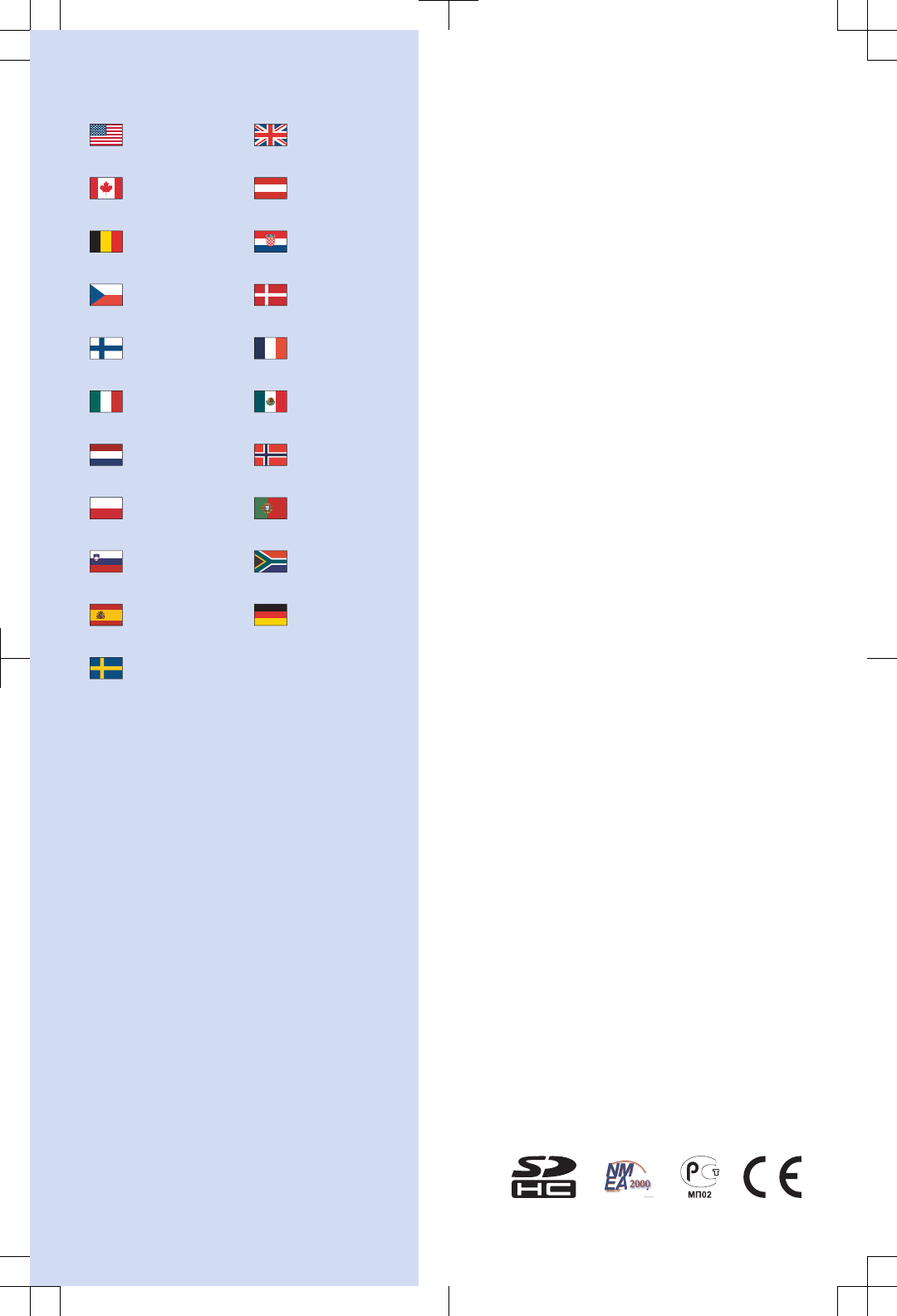
www.garmin.com/support
913-397-8200
1-800-800-1020
0808 238 0000
+44 (0) 870 8501242
1-866-429-9296 +43 (0) 820 220230
+ 32 2 672 52 54 +385 1 5508 272
+385 1 5508 271
+420 221 985466
+420 221 985465 + 45 4810 5050
+ 358 9 6937 9758 + 331 55 69 33 99
+ 39 02 36 699699 (+52) 001-855-792-7671
0800 0233937 +47 815 69 555
00800 4412 454
+44 2380 662 915 (+35) 1214 447 460
+386 4 27 92 500 0861 GARMIN (427 646)
+27 (0)11 251 9999
+34 93 275 44 97 +49 (0)180 6 427646
20 ct./Anruf. a. d. deutschen
Festnetz, Mobilfunk max. 60 ct./Anruf
+ 46 7744 52020
Garmin International, Inc.
1200 East 151st Street
Olathe, Kansas 66062, USA
Garmin (Europe) Ltd.
Liberty House, Hounsdown Business Park
Southampton, Hampshire, SO40 9LR UK
Garmin Corporation
No. 68, Zhangshu 2nd Road, Xizhi Dist.
New Taipei City, 221, Taiwan (R.O.C.) © 2013 Garmin Ltd. or its subsidiaries
DRAFT